Google E-E-A-T represents Proficiency, Competence, Authoritativeness, and Dependability. It’s a model that Google utilizes to assess the quality and reliability of content.
| Google E-E-A-T | Description |
|---|---|
| Experience | Refers to the extent to which the content creator has the necessary first-hand or life experience required for the topic |
| Expertise | Reflects the author’s level of knowledge or skill on the topic |
| Authoritativeness | Measures the extent to which the content creator or the website is known as a go-to source and is well-established and respected in the field |
| Trustworthiness | Assesses the level of accuracy, honesty, safety, and reliability of the website |
Comprehending E-E-A-T and showcasing it are two distinctly different tasks.
In How to Design an SEO Strategy, we discloses examples, trials, and campaigns illustrating how he utilizes SEO to direct traffic to Backlinko.
This type of content naturally adheres to the standards of E-E-A-T.
The outcome?
Attaining the top position for the keyword “SEO strategy.”
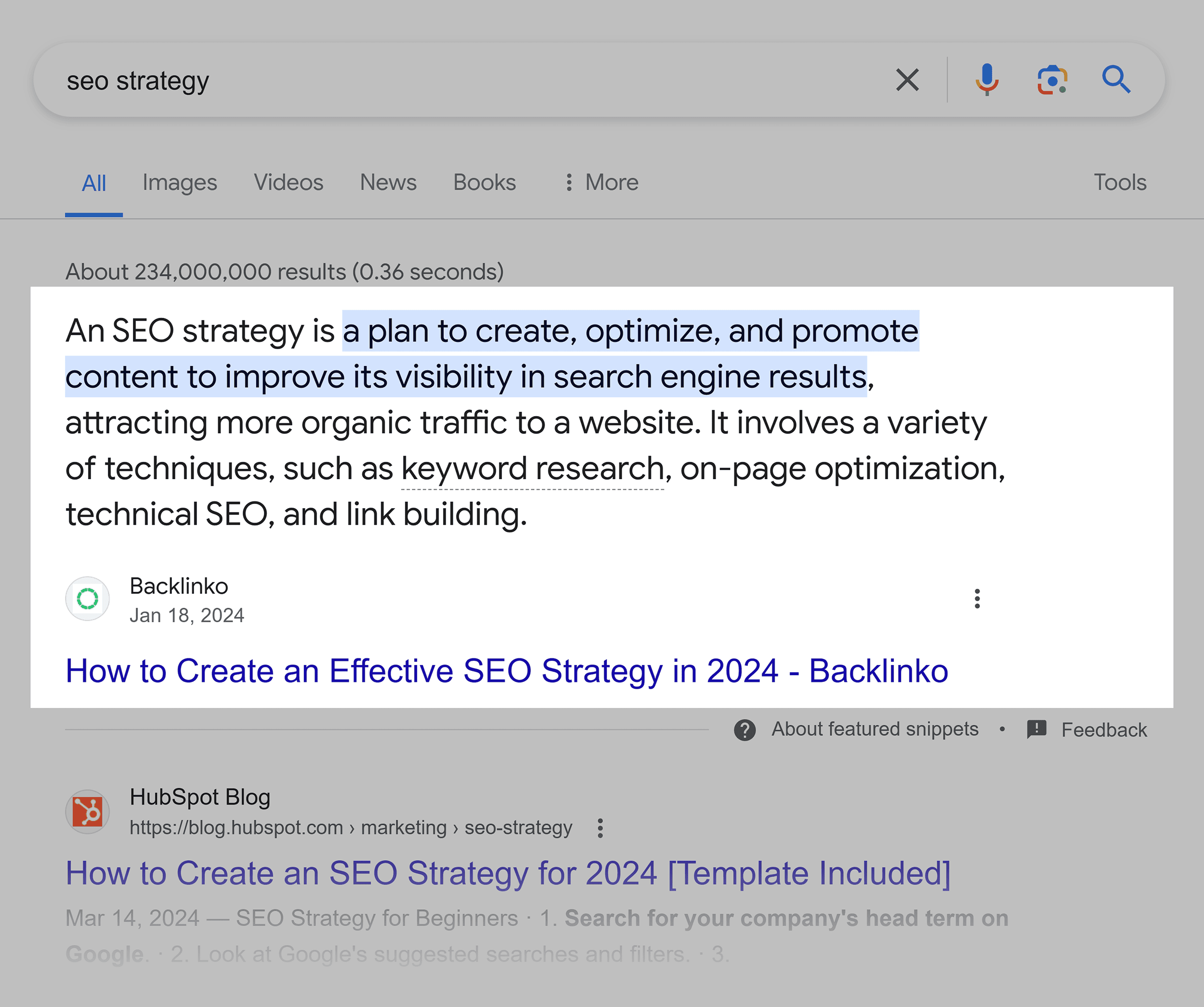
Note the strategy employed?
The remaining part of this handbook will clarify:
- What E-E-A-T is not
- Why it’s important
- The fundamental components
- The various tiers of E-E-A-T, in accordance with Google’s Quality Rater Guidelines
- Practical techniques to construct and display E-E-A-T
What E-E-A-T Is Not
E-E-A-T is regularly misinterpreted, overcomplicated, and disregarded. Let’s get the facts straight.
Myth #1 – E-E-A-T Is Not a Ranking Element
Despite its significance, E-E-A-T is not a ranking determinant.
To grasp this better, let’s delve into history.
E-E-A-T isn’t a new concept. Google introduced the notion of E-A-T (more on its progression into E-E-A-T shortly) in its Quality Rater Guidelines back in 2014.
Google’s Quality Rater Guidelines are utilized by the search engine’s autonomous evaluators recognized as “Quality Raters.”
“Raters evaluate how well content responds to a search query and assess the quality of results by considering the content’s proficiency, authoritativeness, and reliability. These evaluations do not directly influence rankings but aid in evaluating the quality of our results and ensuring they meet a global high standard.”
E-E-A-T isn’t a ranking factor in the conventional sense of ranking factors.
Rather, view E-E-A-T as a mentality for crafting useful and user-focused content. It’s about offering what individuals anticipate from your website, fostering their trust.
Myth #2 – E-E-A-T Is Not a Checklist
As much as we wish it were, E-E-A-T is more intricate than a catalog of definitions. Forming and showcasing E-E-A-T doesn’t manifest identically for every business or niche.
Users exploring diverse content types in various niches have distinct expectations of valuable and reliable content.
This was crystal clear in December 2022 when Google appended an extra “E” to E-A-T, forming E-E-A-T.
The added “E” denotes Experience.
This action revealed Google’s heightened emphasis on real, personal involvement or direct familiarity with the subject discussed in a piece of content.
Why?
Users crave insights from individuals with experience in the topic they’re exploring.
However, not every subject mandates formal expertise for its content to be deemed worthwhile. Frequently, firsthand experience carries as much, if not more weight.
For example, epicgardening.com is recognized as one of the premier gardening websites globally, attracting around 563,000 organic monthly search visits.
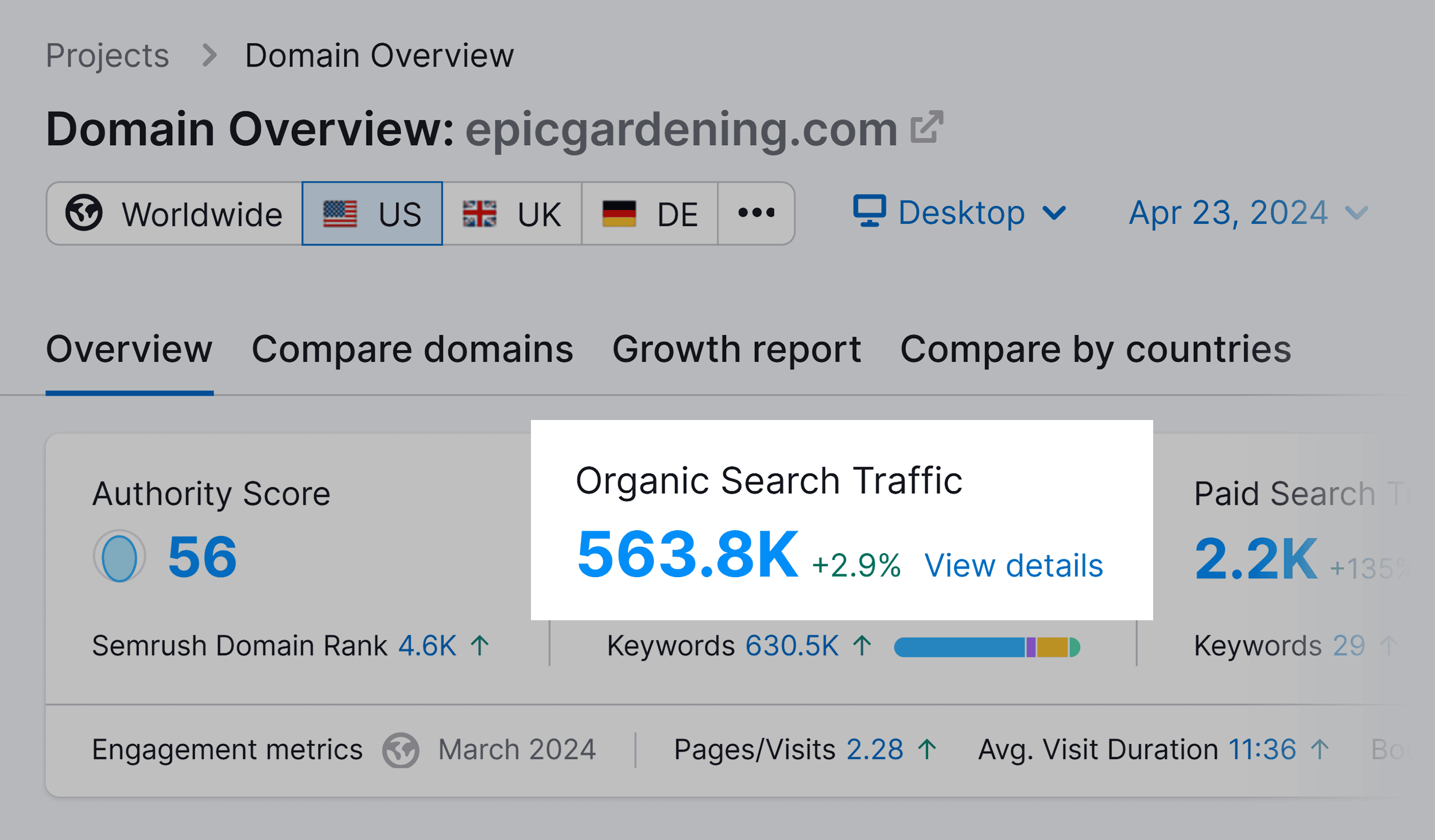
Nevertheless, the founder, Kevin Espiritu, lacking official qualifications in horticulture or landscaping, amassed an audience by divulging his discoveries from experimenting in his garden.
Presently, Epic Gardening employs a team of gardening specialists to generate content and boost their E-E-A-T.
Upon introducing E-E-A-T, Google enforced the notion that the “T” (trust, just in case you overlooked it) is the bedrock of E-E-A-T and carries immense importance.
And this logic is sound.
Ponder this: If users lack trust in your content, what value does it hold?
In spite of popular belief, E-E-A-T isn’t just about displaying these four elements on your site. It’s also about ensuring they are showcased off-site.
An effective approach to envision exhibiting E-E-A-T entails confirming you share your experience, proficiency, authoritativeness, and dependability on-site and validating this with off-page cues.
Being trusted and deemed authoritative is as much about external endorsements as it is about self-assertion.
When you dissect E-E-A-T into on-page and off-page elements, forming strategies to create and exhibit it becomes much more feasible.
Why E-E-A-T Matters
Given the rapid evolution of AI, it’s now simpler than ever to auto-generate content not originating from an individual with direct experience or expertise.
In 2023, SEO authority Matt Digity exclusively leveraged AI to produce 526 articles for a new website by simply pressing buttons. The website achieved over 50,000 sessions per month.
Hence, E-E-A-T has emerged as an increasingly vital means to ensure your content aligns with what Google’s ranking algorithms favor.
It’s quite certain that Google will continue to devise methods to deter low-value AI-generated content from securing positions in the search engine results pages (SERPs), and it’s plausible that E-E-A-T will play a role in this process.
There’s also a likelihood that Google is utilizing feedback from Quality Ratings to train its AI-based ranking systems and algorithms.
In October 2023, numerous deep-learning models utilized in ranking webpages were trained or refined with IS (Information Satisfaction) scores. These scores are constructed based on ratings from search quality raters.
This implies that your content and website need to align with the expectations of these ranking systems. E-E-A-T probably plays a significant role in this aspect. After all, pages with high or very high E-E-A-T deserve a higher ranking.are generating a higher IS rating.
Furthermore, as Google continues to recognize content produced by specialists or individuals with direct experience, we can anticipate that content aligning with these criteria will be positively impacted in the core algorithm and other Google updates moving forward.
E-A-T is significant and will only grow in importance.
The Fundamental Components of E-E-A-T
Lets delve deeper into each of the four components that constitute E-E-A-T.
Hands-on Engagement
When Google mentions "hands-on engagement," it refers to real-world, direct involvement with the subject matter of a content piece.
This could include:
- The author of a hotel critique staying at the hotel they are evaluating
- The author of a list of "top books" having personally read each recommended book
- The author of a product review having physically tested the product
An authentic engagement with a subject is presently beyond the capabilities of AI. While AI may seek to mimic certain aspects of human experience, its content lacks genuine originality.
Google considers engagement as a crucial element in distinguishing human-created content from AI-generated content. However, it’s also an expectation from users.
Here are some instances provided by Google in its Quality Rater Guidelines to illustrate the importance of engagement and when information or advice is best handled by experts:
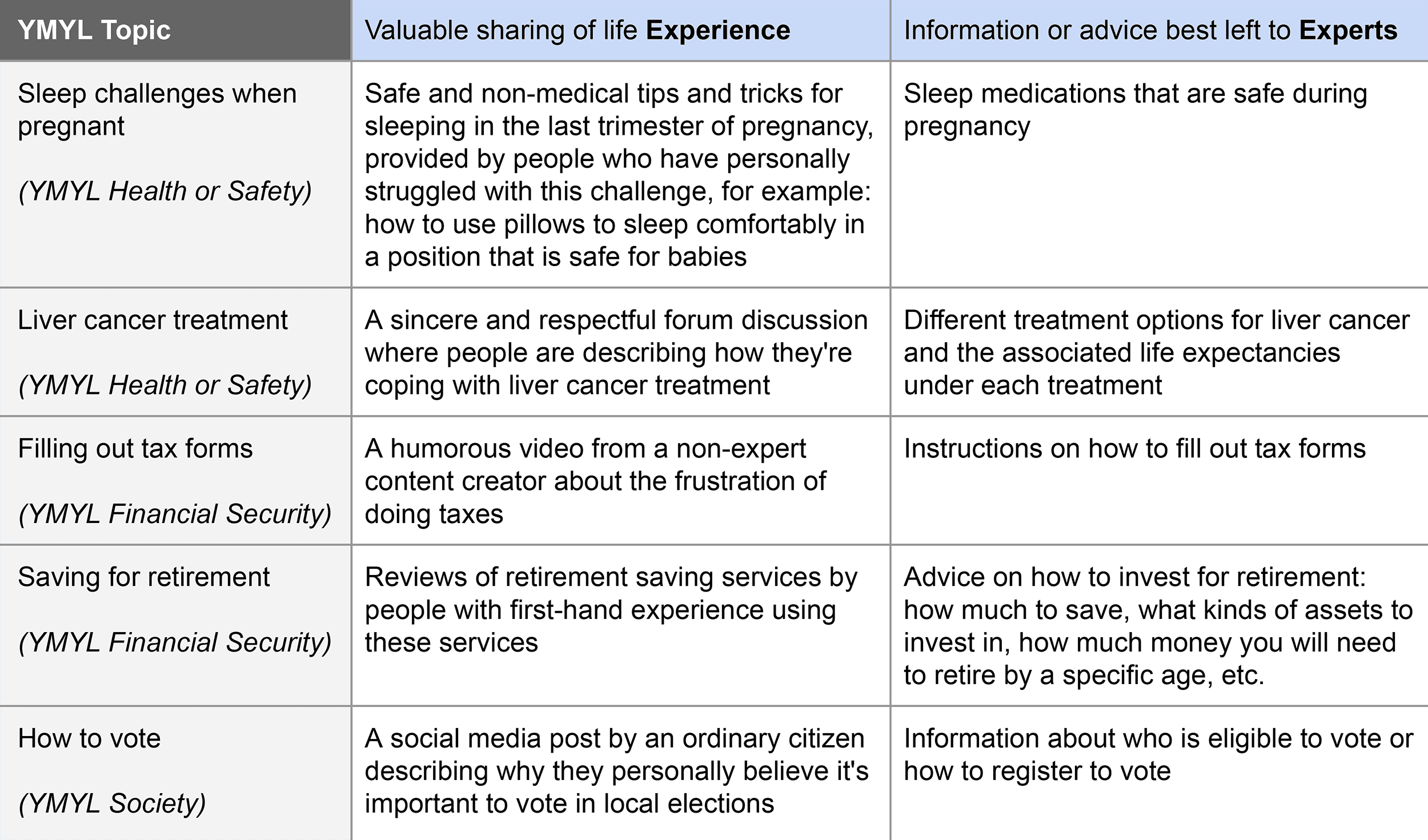
Engagement is vital in showcasing when developing content.
So, how can you illustrate this engagement?
Lets explore.
Ways To Acquire and Display Engagement
One of the most efficient approaches to showcase your engagement is by presenting evidence of the direct engagement you’ve acquired.
Suppose you manage a travel blog.
Your readership consists of travel enthusiasts seeking inspiration and suggestions for their next trip.
And you’re reviewing a hotel you’ve stayed at.
To display direct engagement, you must present proof that you have visited this hotel.
While this should be standard practice, numerous travel bloggers have critiqued hotels they never stayed at. They rely on the hotel’s photographs and descriptions or mimic content from another travel blogger who invested effort and resources to visit the hotel.
To manifest this engagement, you could:
- Utilize your personal photographs and video content rather than official images from the hotel’s website
- Express your viewpoints on what you appreciated and disliked about the hotel within the content
- Incorporate details that only someone who visited the hotel would be aware of, as opposed to easily accessible information online
For instance, travel author and photographer Emily Lush penned an article about her stay at the Sheki Karvansaray Hotel, one of Azerbaijan’s most extraordinary accommodations.
While reading the article, you can observe that Emily has watermarked all her photographs and has included exclusive insights that only a hotel guest could provide.
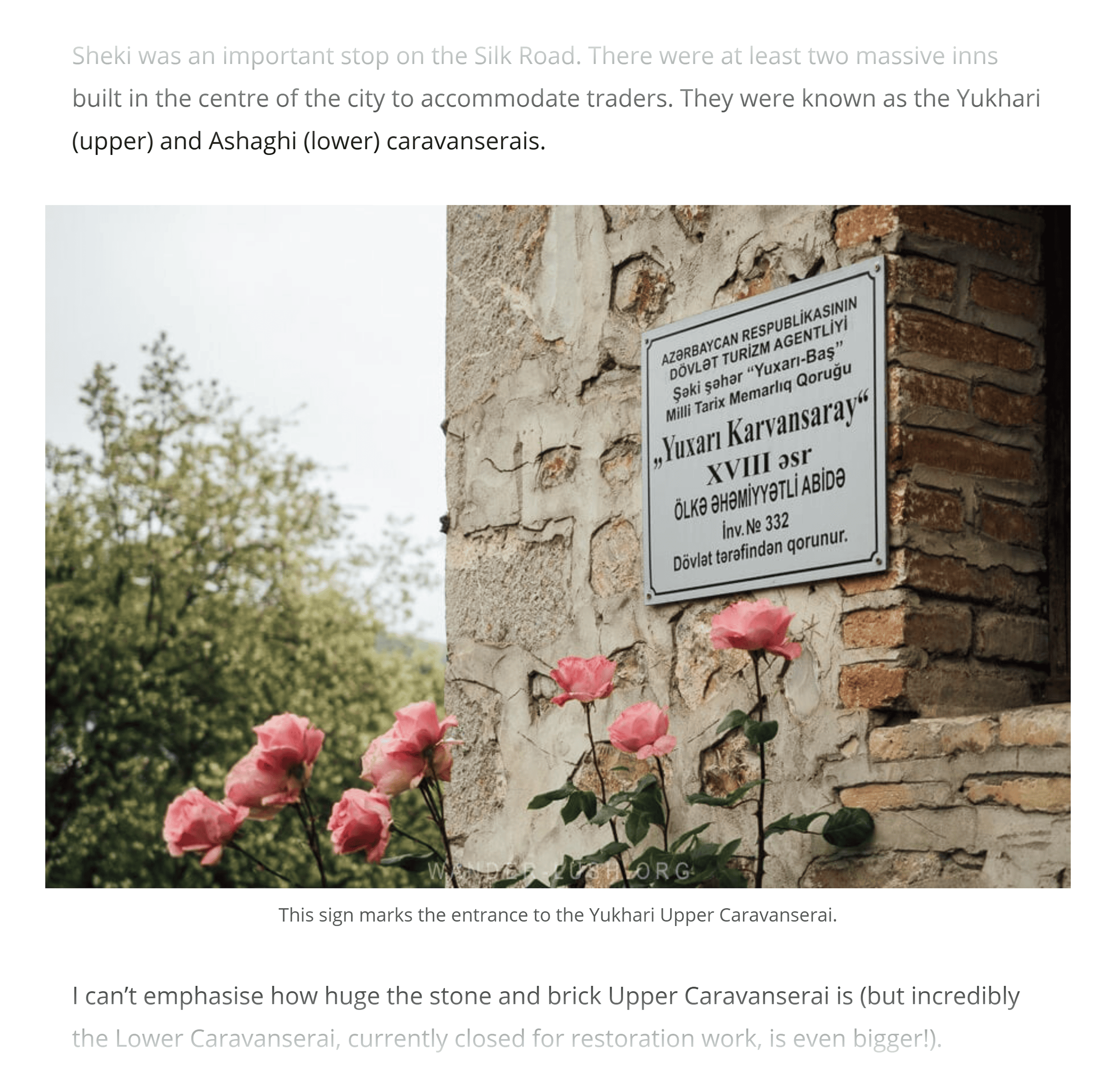
Emily describes the stonework’s scale and mentions specific areas that were inaccessible during her visit.
Emily possesses firsthand experience with this hotel; readers can discern this through her photographs and textual descriptions.
Google’s Quality Raters would likely interpret this as a commendable demonstration of direct engagement.
There would be little room for debate on whether this blogger visited the hotel she reviewed. After all, there’s a photo of her spouse at the hotel.
Proficiency
Google perceives proficiency linked to the content creator. It pertains to their formal (or informal) education or how they attained their skills.
Google’s Quality Raters raise queries such as:
- Who is the primary influencer behind the content?
- Is the creator well-versed in the subject matter?
- What is the creator’s standing within the discipline?
Similar to engagement, proficiency’s significance varies based on the content type and subject.
Demonstrating proficiency is crucial in fields like finance and healthcare. In these scenarios, you are anticipated to offer information adhering to the prevailing medical or financial consensus.
Your accreditations, academic accomplishments, and standing within your sector are also pivotal when developing such content.
Nonetheless, everyday competence can also be regarded as proficiency for certain subjects and content types.
To elucidate this further, let’s consider an example.
If you are interested in baking sourdough, you search "sourdough recipe" on Google.
Below are the outcomes:
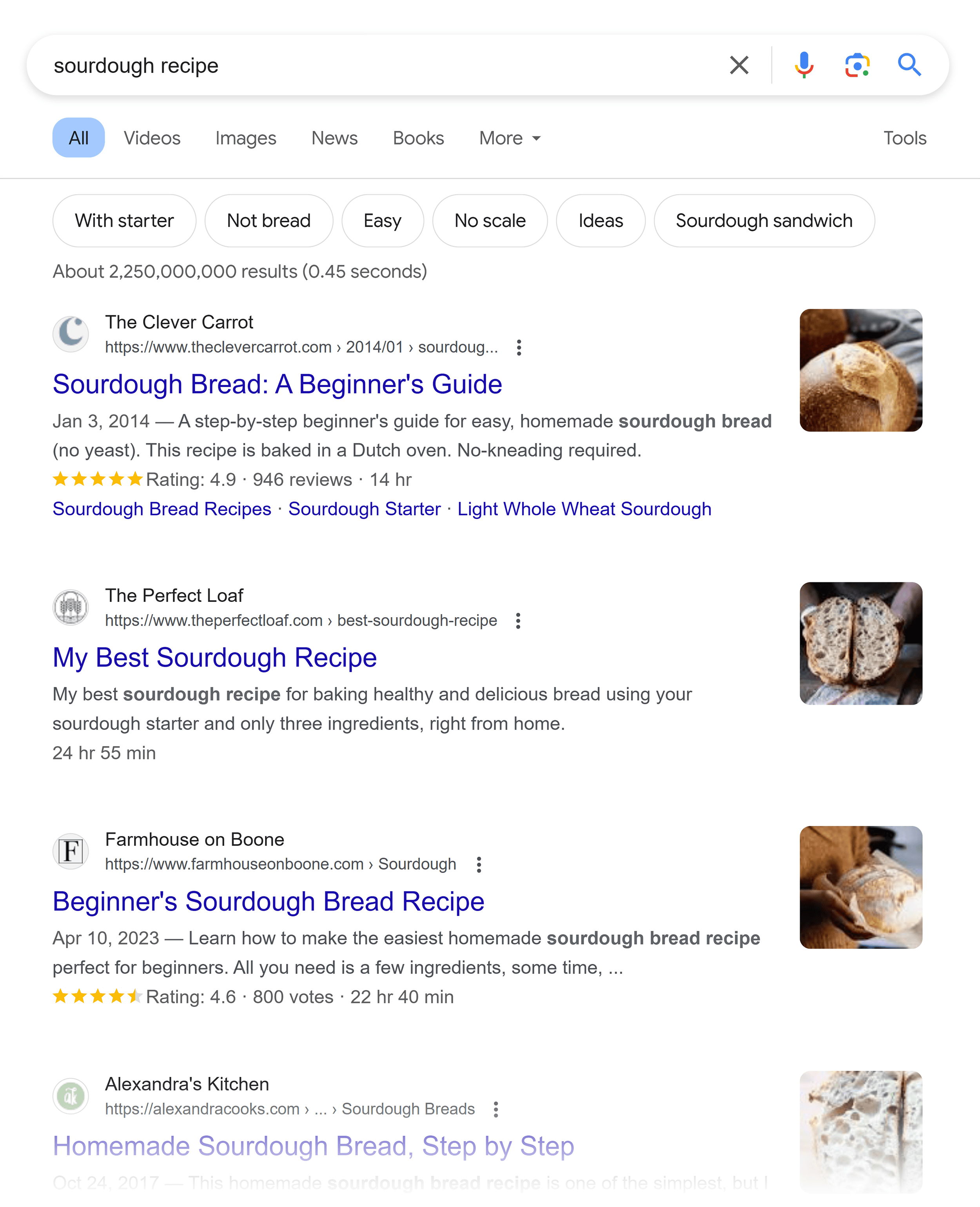
Here are the credentials of the top three positions:
- Position #1: Emilie Raffa is the mind behind The Clever Carrot. Emilie received classical training at the Institute of Culinary Education and is the proprietor of an Italian restaurant in New York City.
- Position #2: Maurizio Leo is the brains behind The Perfect Loaf. He’s an at-home baker with over ten years of experience baking sourdough bread and authored a bestselling baking book.
- Position #3: Lisa Bass, the chef behind Farmhouse on Boone, is a mother of eight without formal baking qualifications. She has a passion for preparing homemade dishes for her family and sharing her creations with her audience.
The spectrum of expertise in sourdough recipes is evident, ranging from formal qualifications to authors, restaurant owners, and busy mothers.
Given the rankings, Google’s Quality Raters would likely respect the proficiency in all three recipes and consider the context.
Naturally, this perspective would differ in areas such as finance, medicine, or law, for instance.
For example, if you were seeking an article on healthcare regulations, you would prioritize a qualified professional over an enthusiast.
Methods To Cultivate and Showcase Proficiency
One of the simplest ways to exhibit your proficiency to Google’s Quality Raters is by including details about yourself and other authors contributing to your platform.
It’s advised to feature information about each author in an article, such as their qualifications, professional background, and standing within a specific domain.
For instance, in the case of medical advice, an author possessing a medical degree and extensive experience in the field would be deemed an authoritative source.
Check out this piece from Healthline:
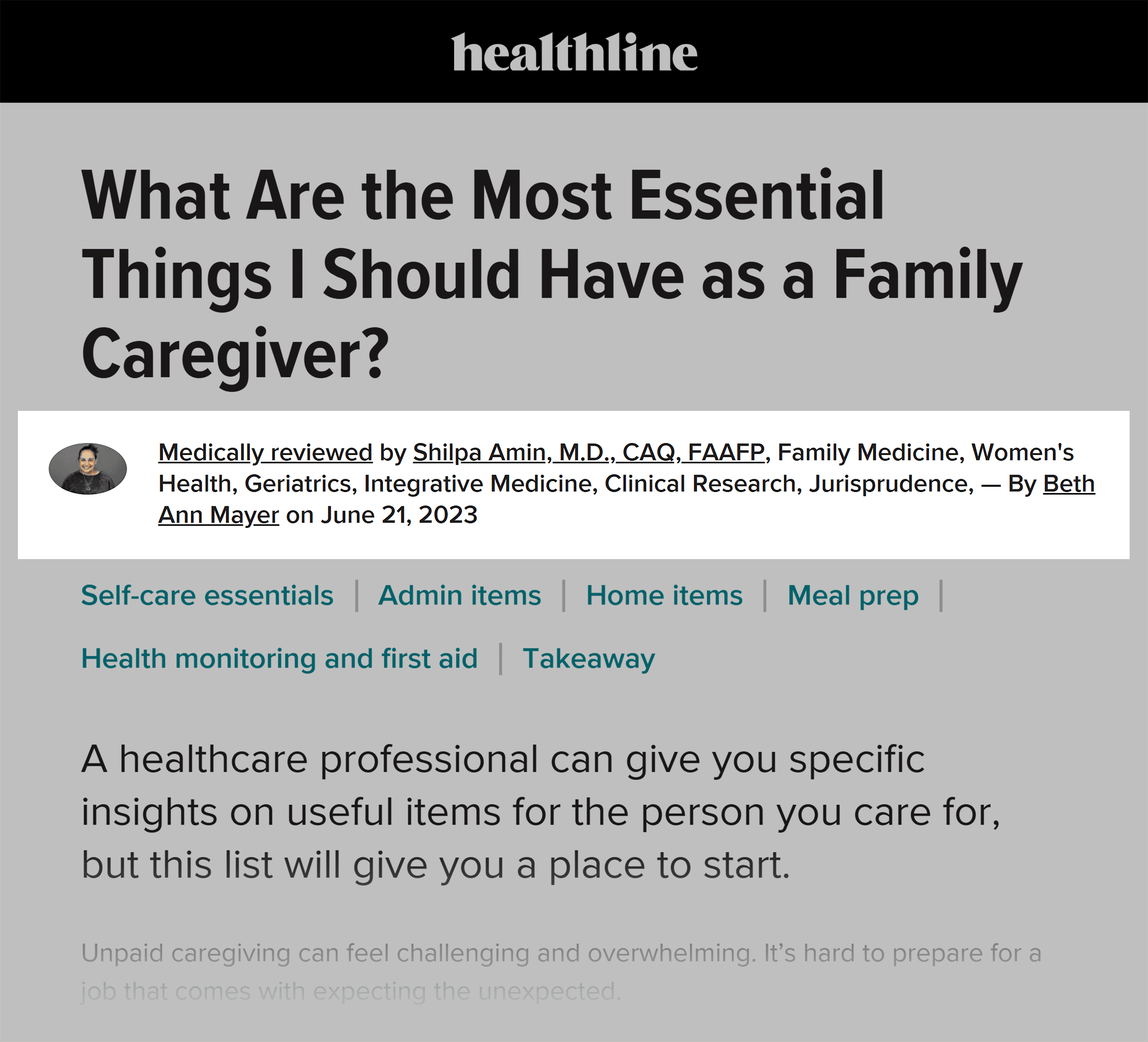
A medical specialist has assessed this article.
Presenting the individual’s credentials showcases their mastery in the field.
Moreover, towards the end of the page, you can find ample details about the writer that further establish credibility and trust.

You can also incorporate references into your content to demonstrate that your perspectives are supported by professional consensus.
Previously, we discussed how day-to-day competence can also be recognized as expertise.
So, what’s an effective method to showcase this form of expertise to Google?
It may seem simple, but focus on writing about topics you are well-versed in.
For example, if you dedicate significant time to working on automobile engines, you should possess a certain level of expertise in that area. You should be capable of developing a blog filled with valuable content regarding common engine issues and more.
Conversely, if you have never baked a cake before and decide to start a blog about baking, it will quickly become apparent to both readers and Google that you lack expertise (or experience) in this domain.
Authoritativeness
Authoritativeness indicates the level of authority a content creator or website possesses. It pertains to how much you are considered a primary source of knowledge on a particular subject.
For instance, the Financial Times is deemed one of the most authoritative sources on finance.
Similarly, ESPN holds significant authority within the realm of sports.
Why is this so?
Take a look at any of the articles on platforms like these, and you will immediately notice the substantial amount of (as expected) experience and expertise being displayed.
You will also observe that these platforms feature:
- Backlinks from other authoritative platforms
- A positive reputation
- Authors with notable personal brands or online profiles as experts in specific subjects
- Robust content architecture covering all facets of a given topic
When evaluating authoritativeness, remember that it invariably goes hand in hand with expertise and experience.
If you lack expertise or experience on a topic, you cannot establish yourself as an authority voice in that domain.
How To Enhance and Showcase Authoritativeness
As mentioned earlier, one strategy to enhance your site’s authority is to acquire backlinks from other reputable websites.
An effective approach is utilizing Semrush’s Backlink Gap tool to identify high-authority websites linking to your competitors’ pages but not yours.
To utilize the Backlink Gap tool, input your domain first, followed by your competitor’s domain. Then, click on "Find prospects."
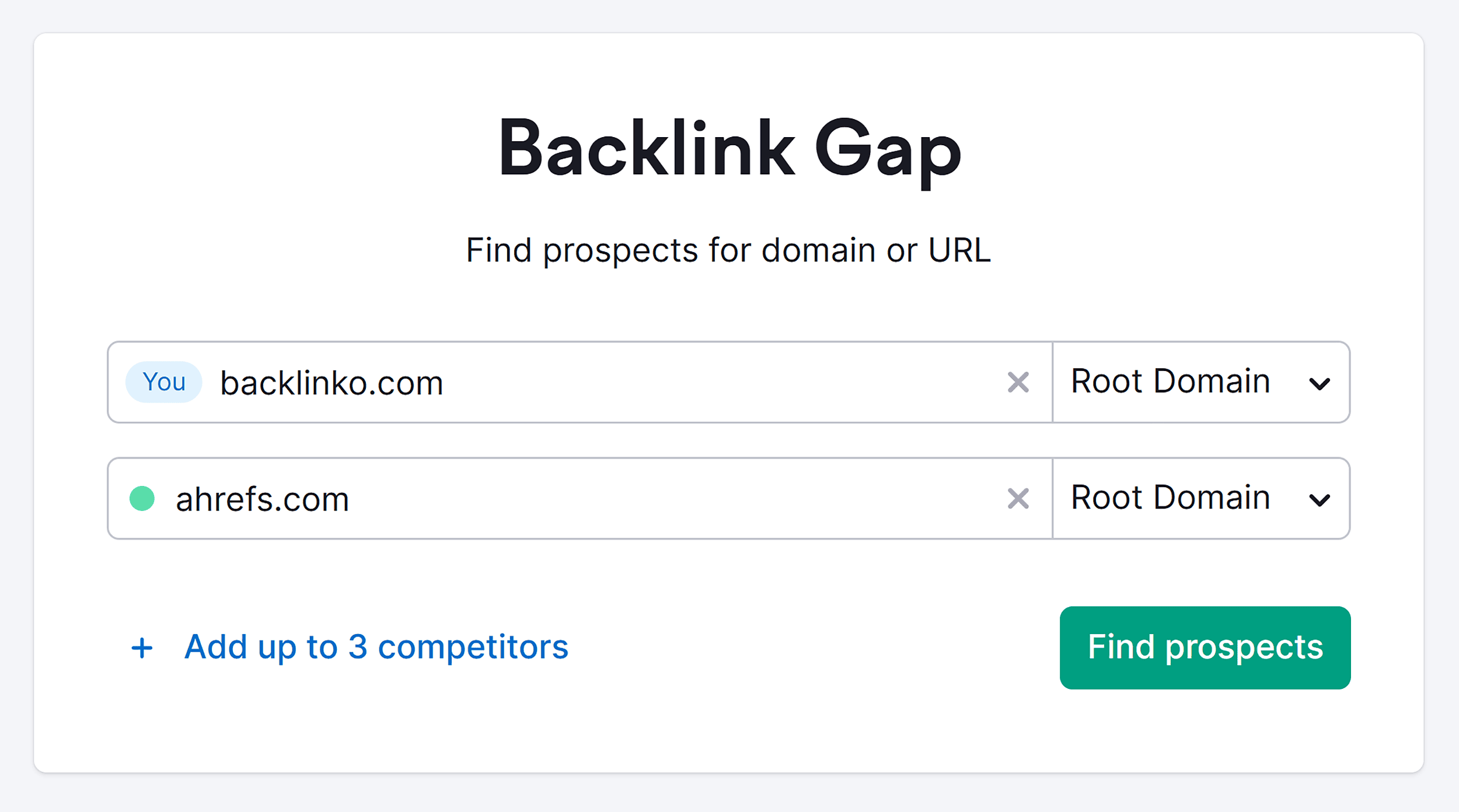
You will then receive a list of referring domains linking to your competitor’s pages. Utilize the “Authority Score” filter to display websites with a high Authority Score—Semrush’s exclusive metric determining website quality.
Click on the "Authority Score" dropdown, choose a custom range of 50 to 100, then click "Apply."
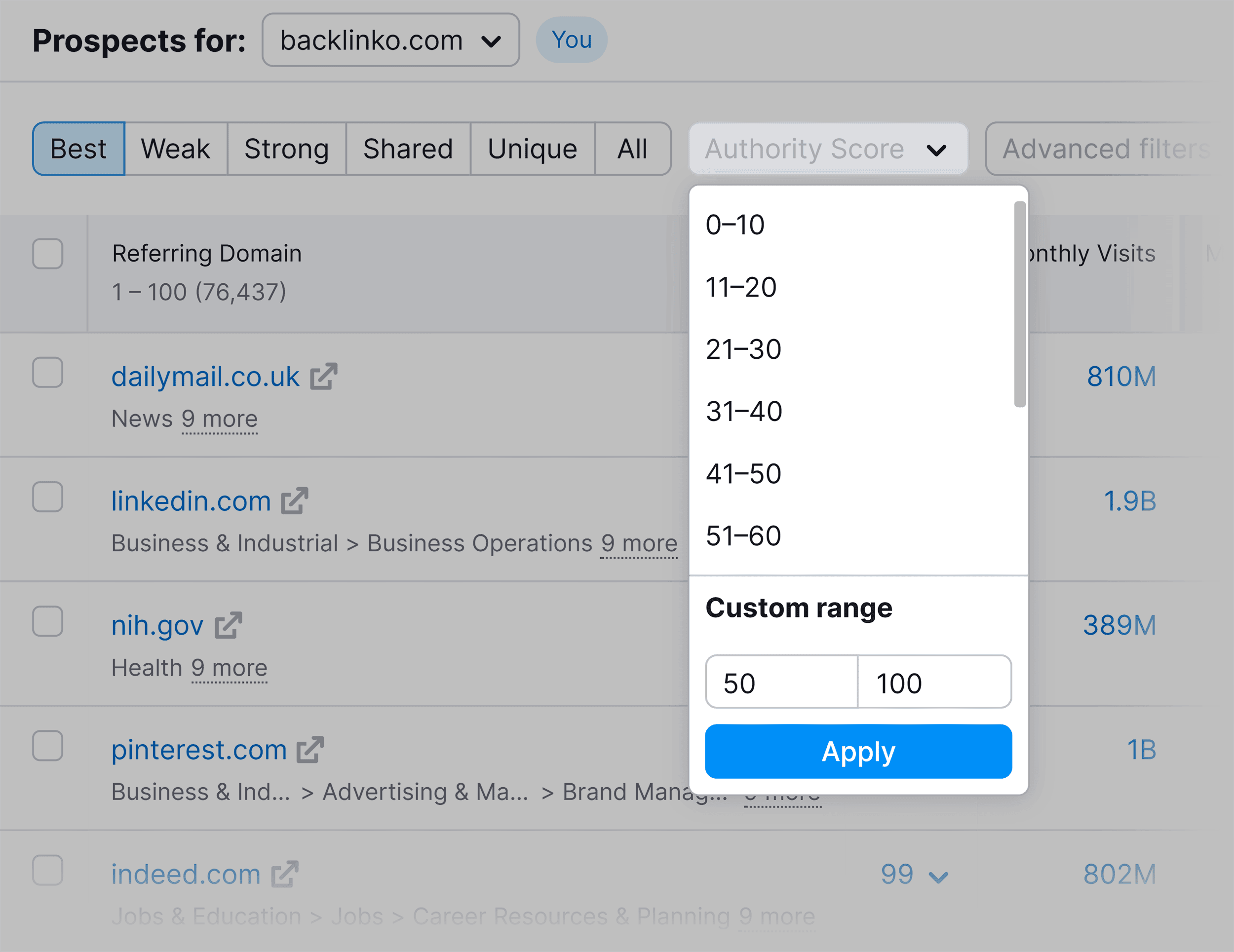
Here, you will exclusively see referring domains with an Authority Score within this range. Assess the list and click on the number under your competitor’s domain.
This action reveals the linked page under “Anchor and Target URL.”
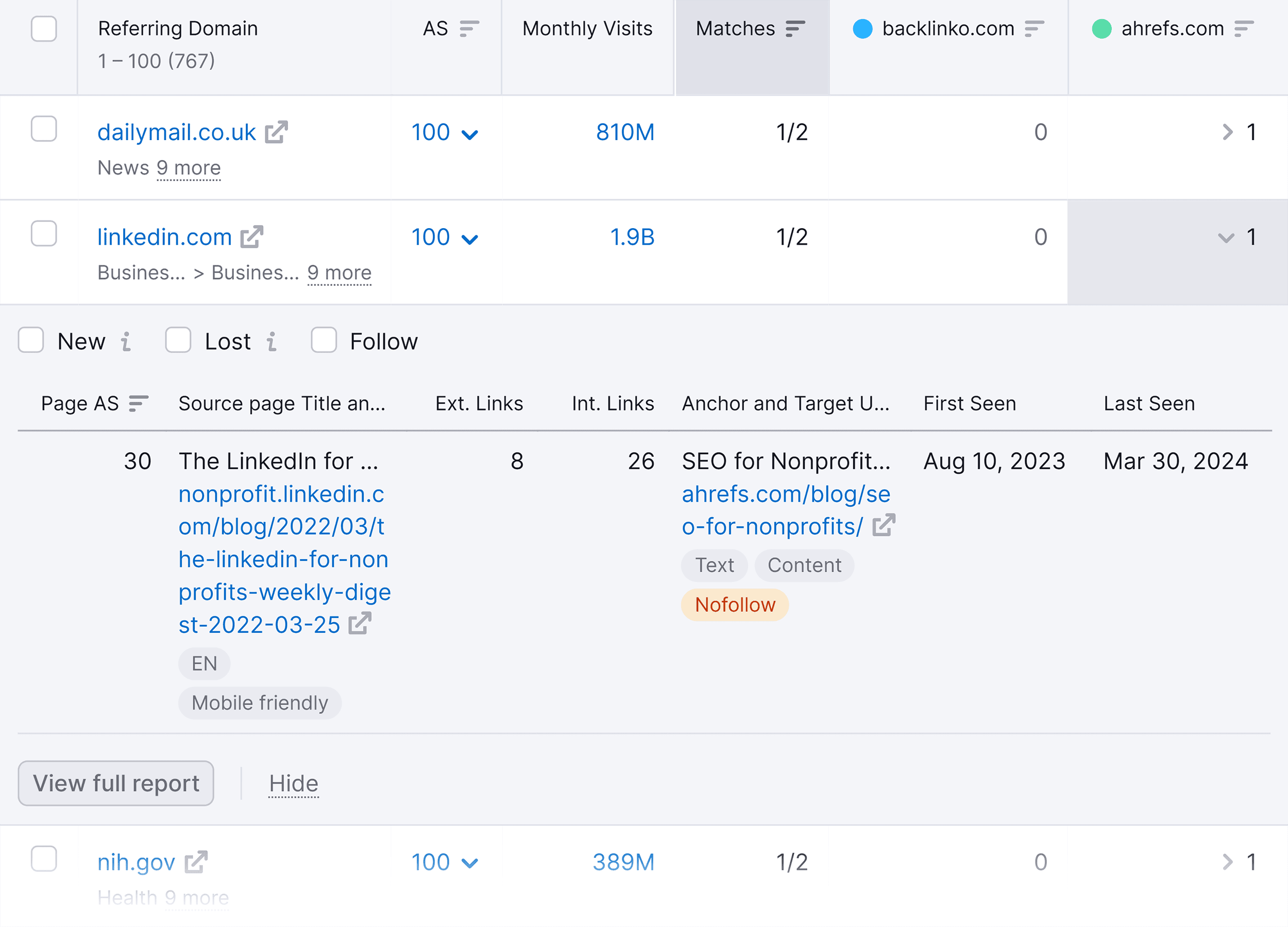
Now, compare your page, if it covers the same topic, against your competitor’s page.
You need to identify content gaps in their material that you can capitalize on and enhance your content to surpass your rivals.
If your site lacks a page about the subject, you should promptly create content around it.
Subsequently, reach out to the referring domain linking to your competitor’s page and endeavor to secure the link for your page.
Once you’ve chosen the referring domains to target, select them and click "Start Outreach."
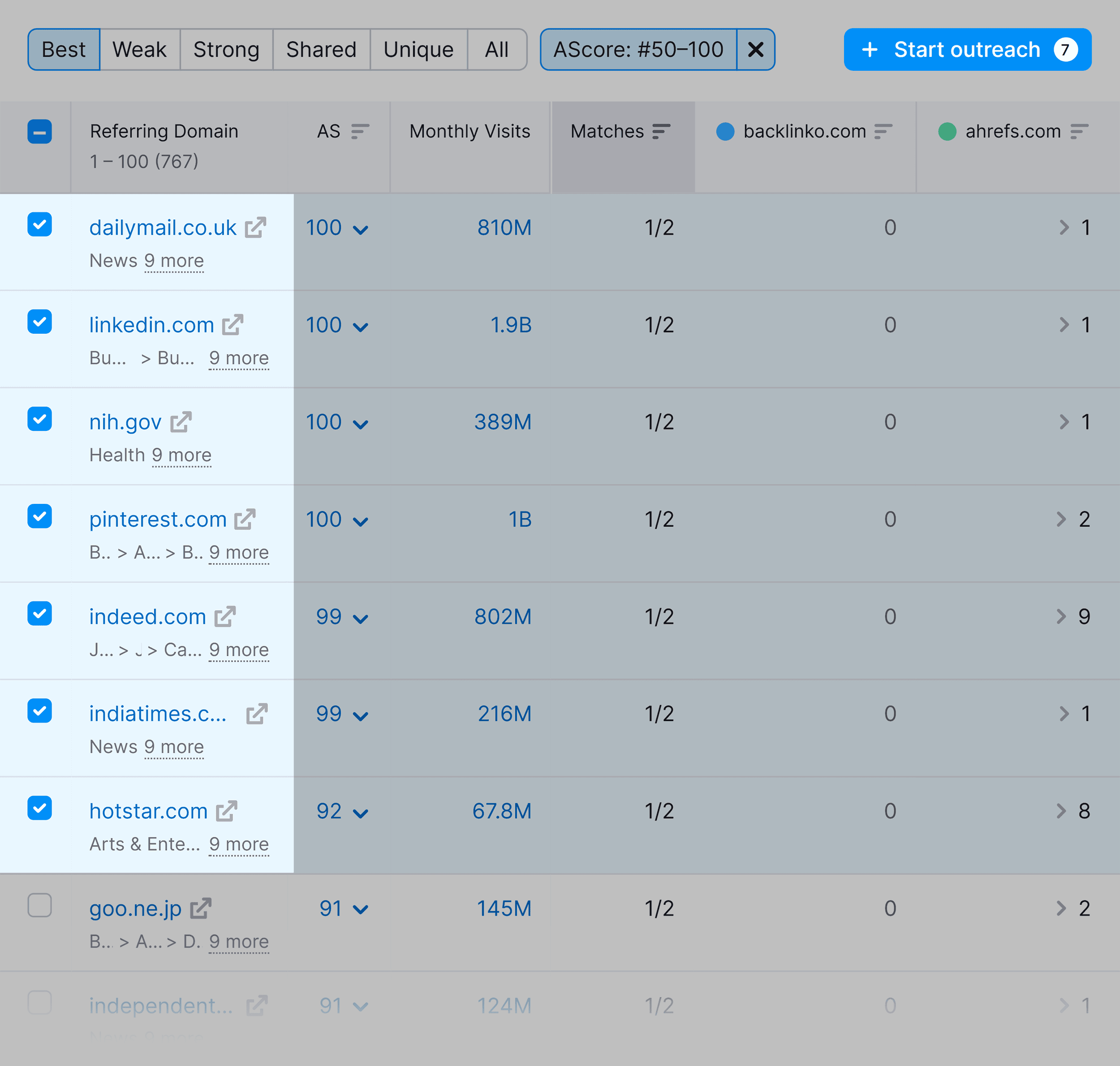
You will see the list of referring domains you’ve chosen to pursue. Then, designate the project to save them and click "Send Prospects."
These referring domains will be stored in Semrush’s Link Building Tool, allowing access at any time.
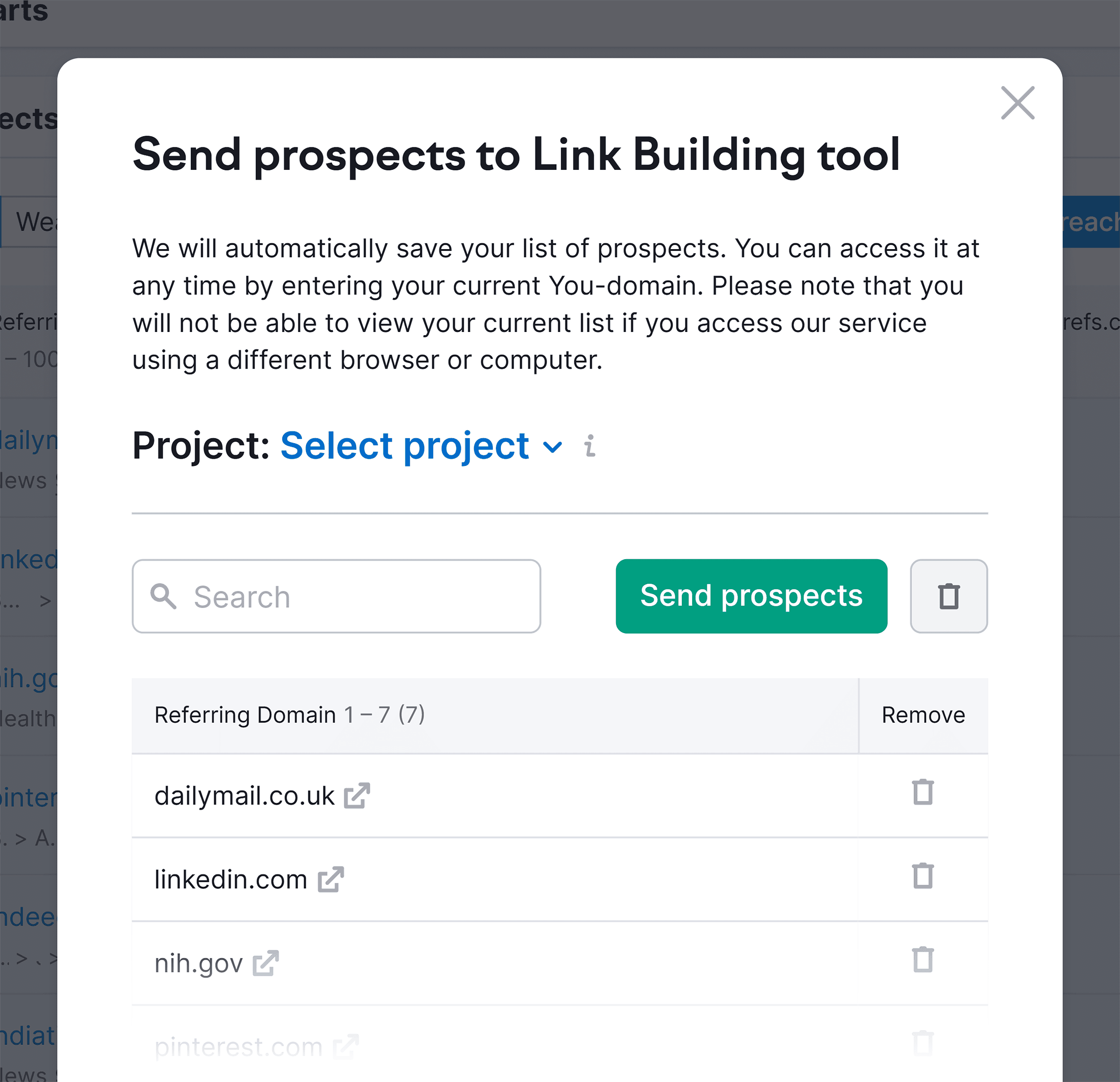
Establishing links with websites in your industry is a superb method of securing authority for your site.
For instance, if a blog post about basketball earns a link from a platform like ESPN, it aids in enhancing the site’s reputation and authority.
Users trust ESPN as a valid voice of authority within the sports field. When they click on a link leading to your page, you are perceived as a trustworthy source, bolstering your authority.
You should strive to establish topical authority on your site as well.
This involves crafting superior content covering all angles of a subject.
Think of it this way:
Imagine you are searching for a fitness trainer to help you attain your fitness objectives. The initial trainer you meet has knowledge of basic workouts. The second trainer is well-versed in advanced training techniques, injury prevention tips, and meal plans.
The third trainer possesses equal knowledge as the prior two but can also showcase expertise through real-life success stories of clients they have assisted.
You are likely to consider the third trainer as the most authoritative option.
The same principle applies to your site.
You should devise a content strategy that assists you in demonstrating your topical authority on a highly relevant subject to your business.
But how can you achieve this?
Endeavor to create as much valuable content as possible covering all facets of your topic.
For example, if you only publish a single article about cycling on your site, Google would be able to detect that.won’t recognize you as a leading figure in the cycling sector.
However, if you consistently publish numerous articles encompassing all facets of cycling, including protective gear, workout regimes, and bicycle maintenance guides, Google will gradually perceive you as a reliable and expert authority.
Your content should provide value and strive to address all inquiries that users may have about the subject.
So, how should you proceed with this endeavor? Initially, undertake keyword exploration to spark content creation ideas. One of the prime tools for keyword exploration is Semrush’s Keyword Magic Tool.
Here is a guide on utilizing it:
Input your main keyword (e.g., “cycling”), and press “Search.”
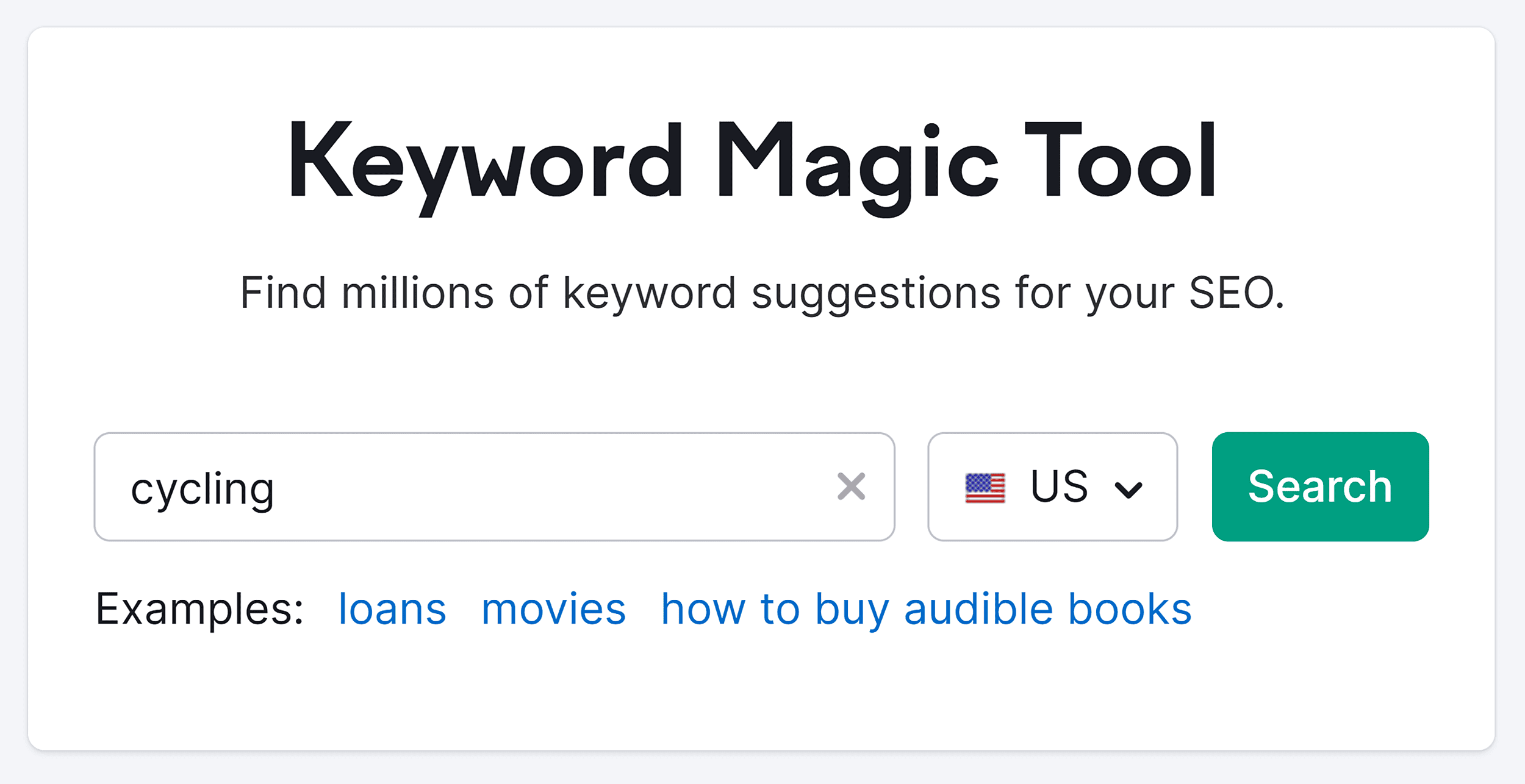
You will receive a list of keywords related to your main keyword, along with their monthly search volume and keyword difficulty ratings.
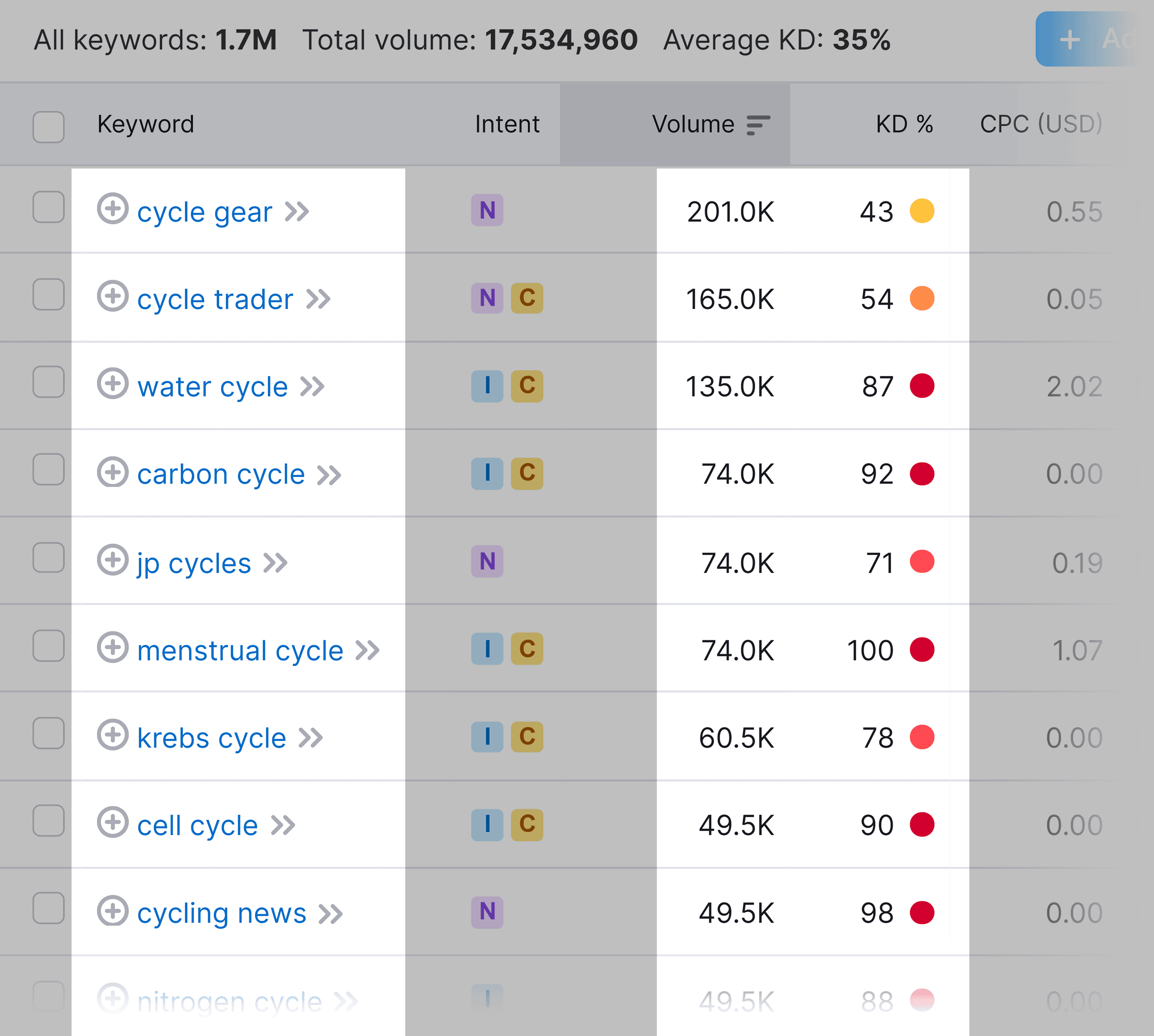
On the left, different keyword groups are available, representing subtopics related to your main keyword.
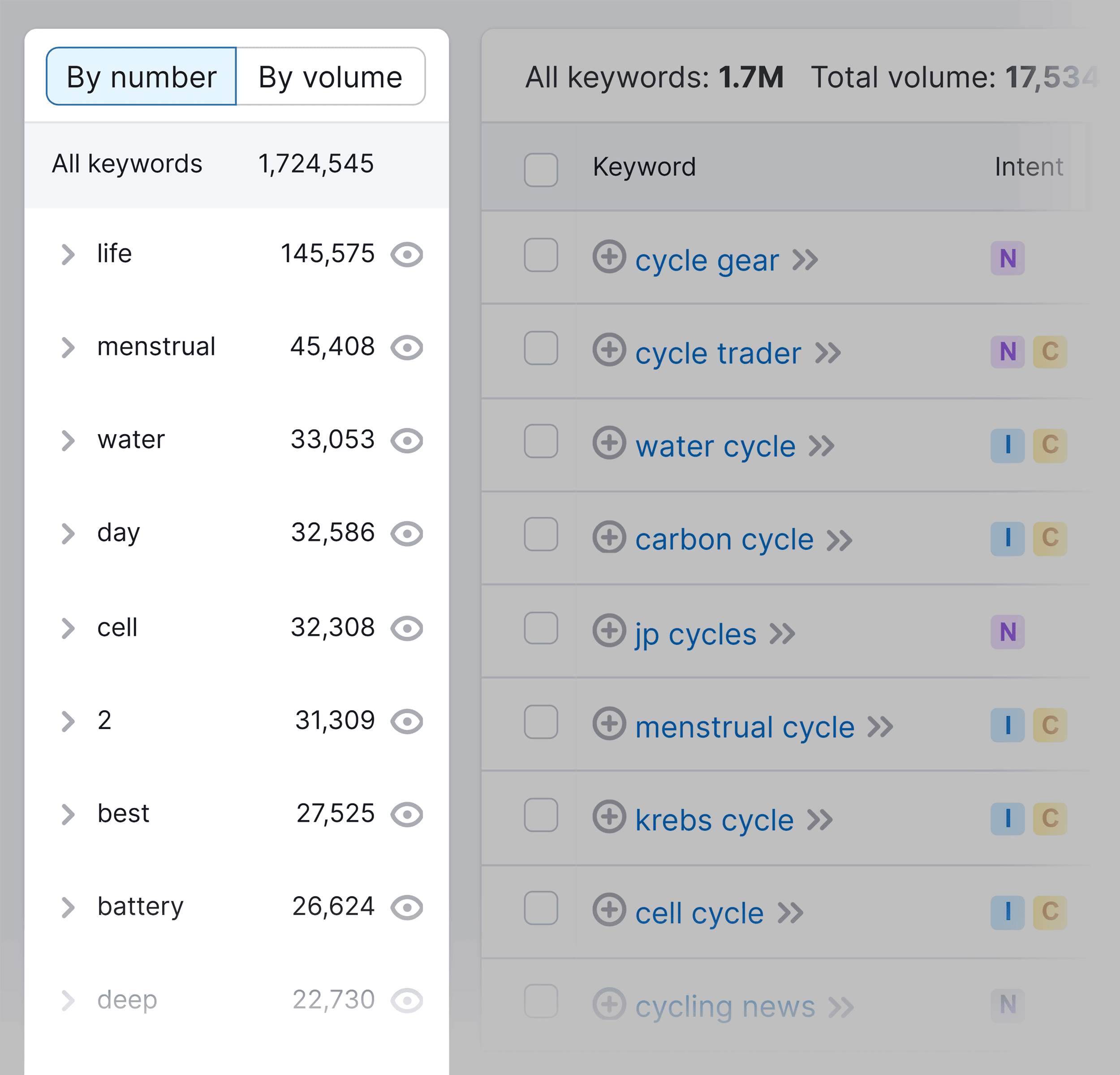
If you select a subtopic, for instance, shoes, a list of keywords related to your main keyword and the subtopic, like “indoor cycling shoes,” will be displayed.
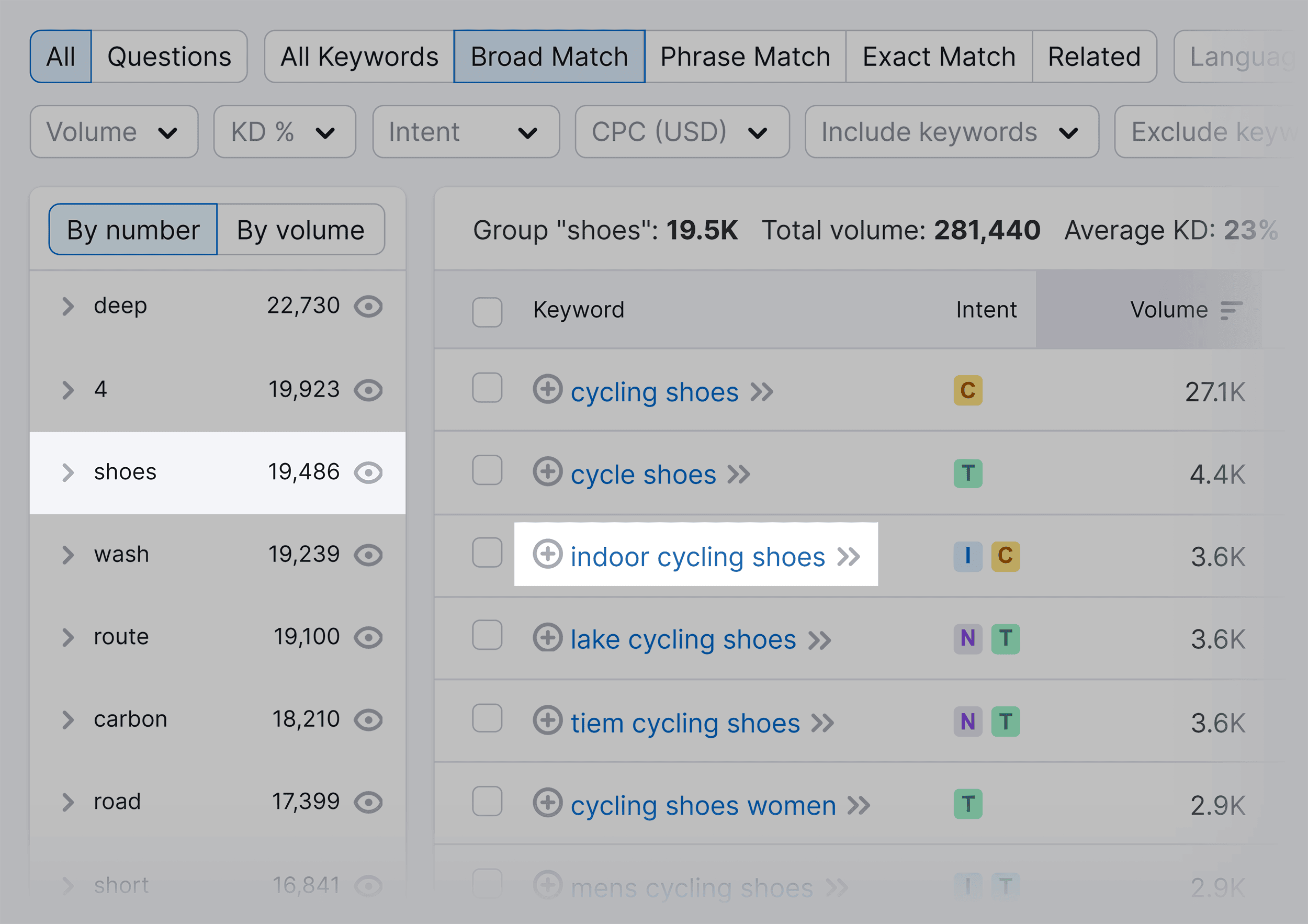
At this point, you will have a significantly broader array of keywords to select from for crafting content.
To save your selected keywords, mark the checkboxes next to them and click “Add to keyword list.”
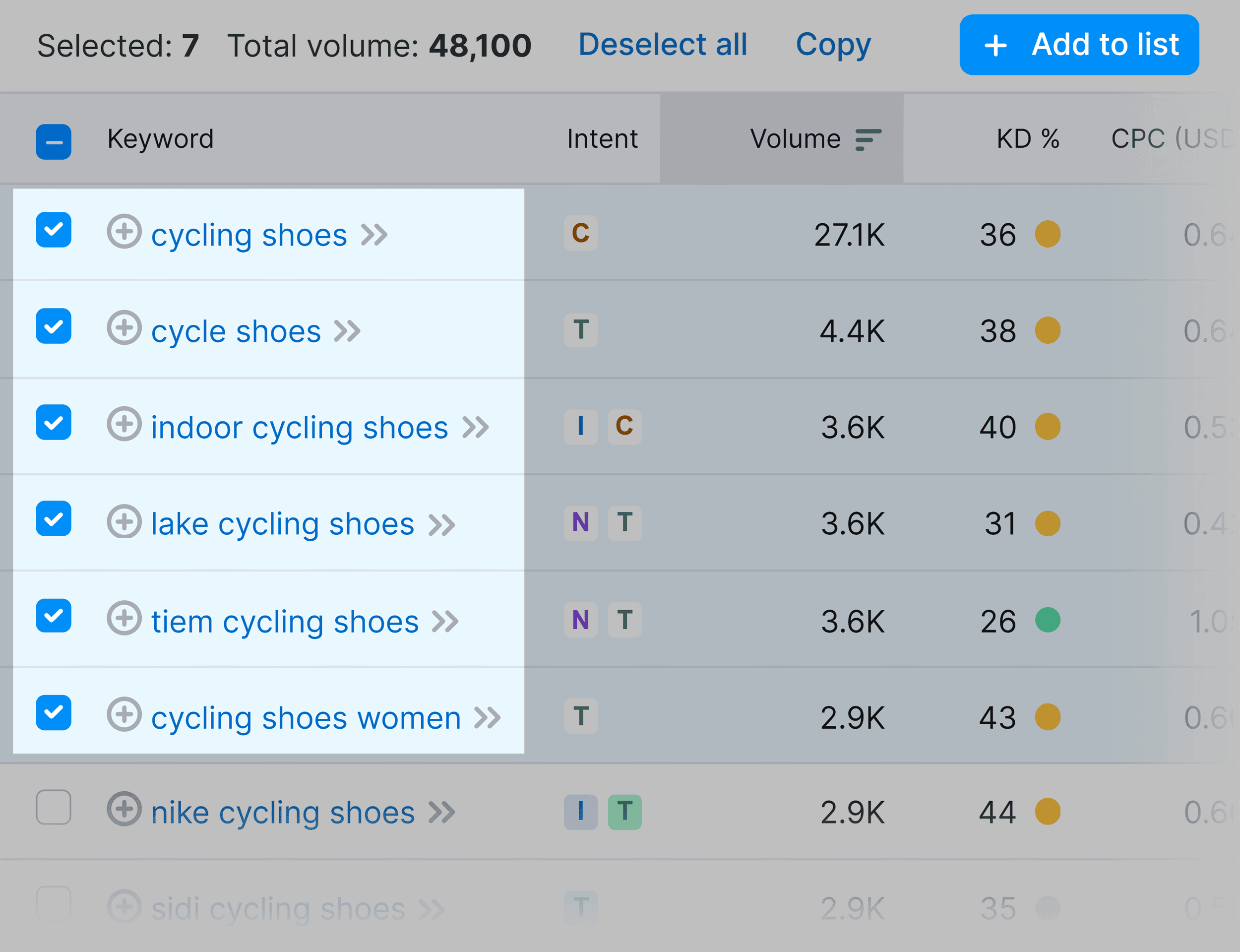
You can then review them using the Keyword Manager tool anytime you wish.
Another effective method to source content ideas is to leverage Semrush’s Topic Research tool. Simply enter a topic into the search bar and click “Get content ideas.”
In this example, we used “gardening.”
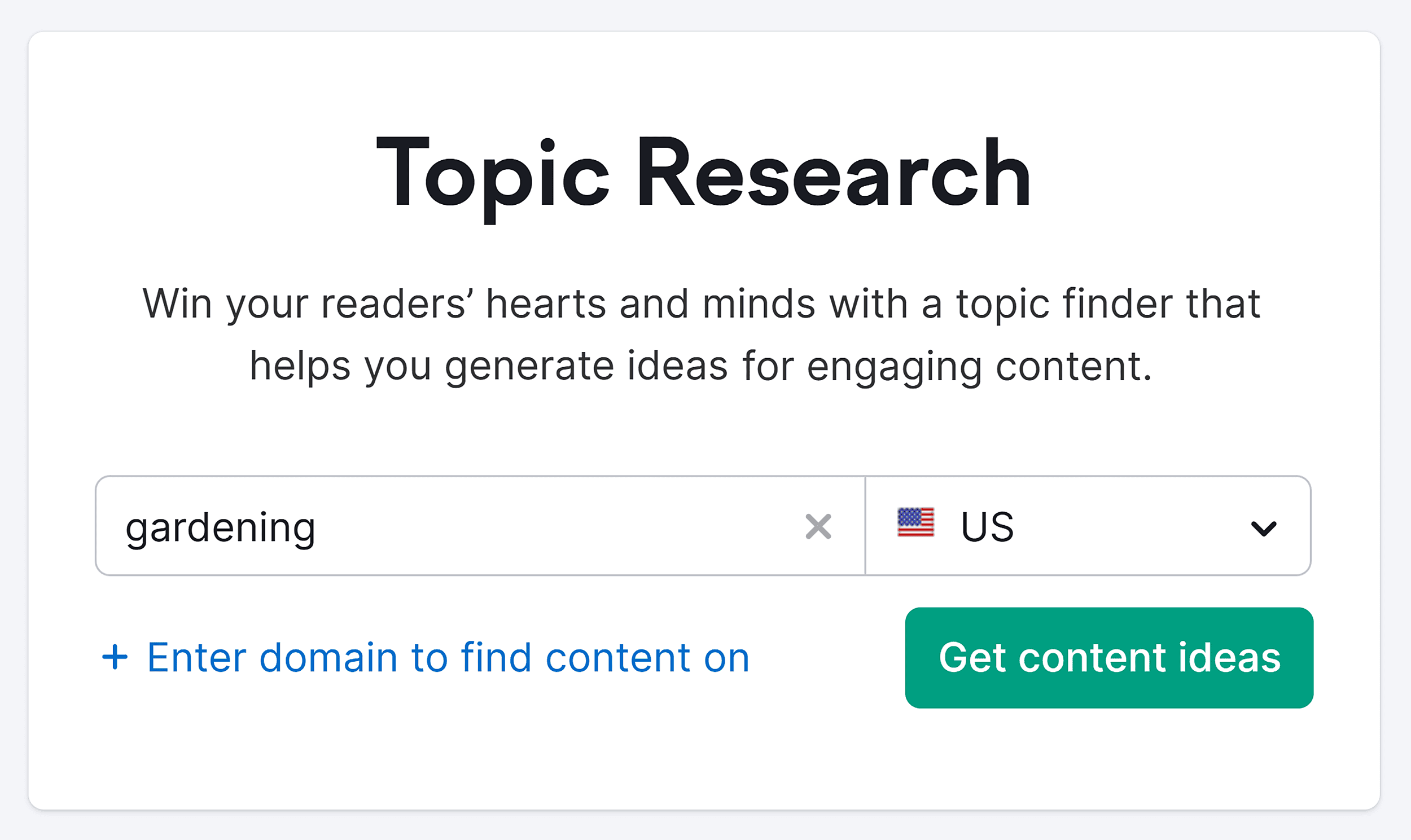
The tool will present cards featuring related subtopics and other pertinent ideas linked to your central topic.
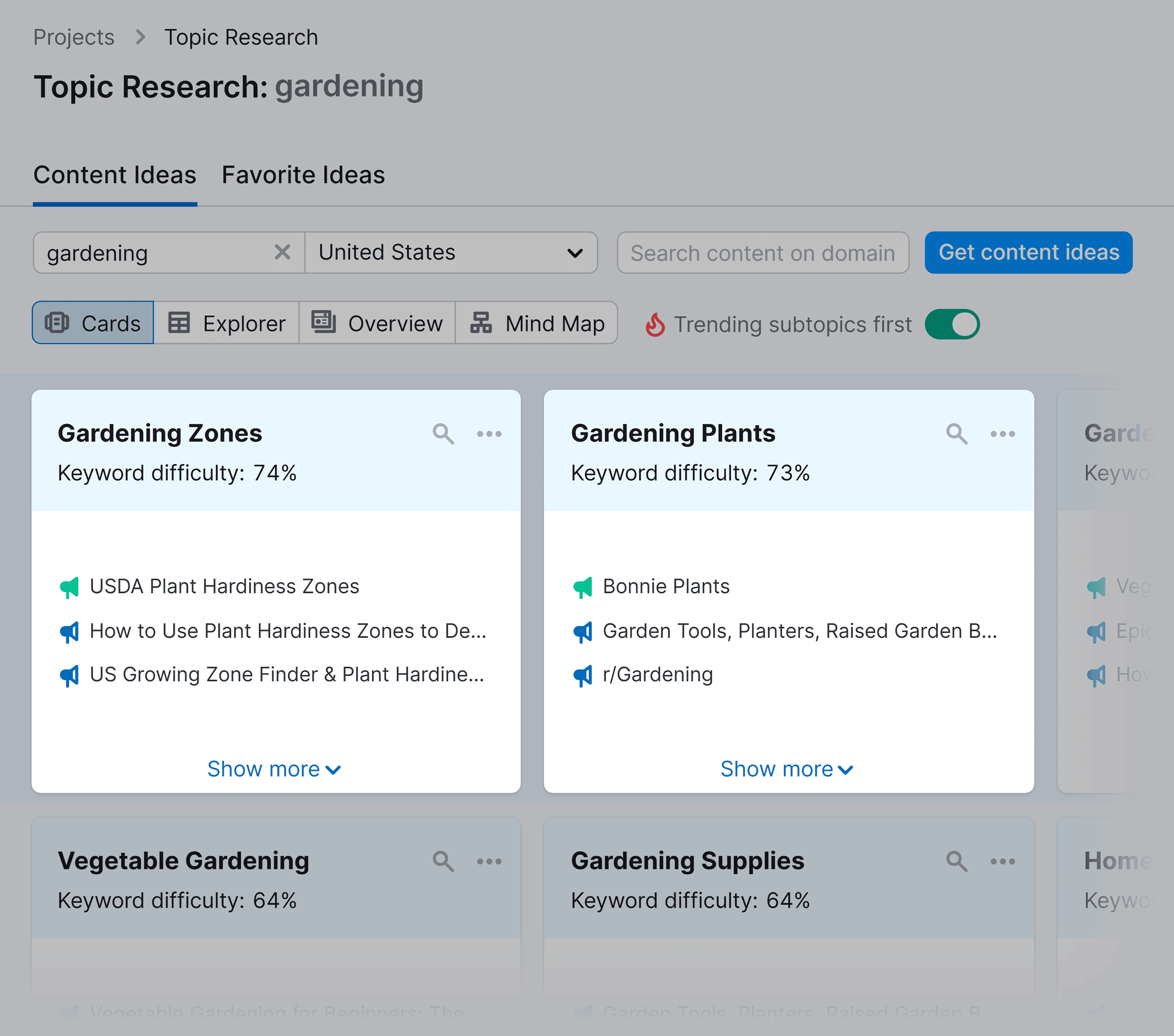
By clicking on a card, you can view the search volume and difficulty, alongside the Topic Efficiency for each topic. This exclusive metric aids in identifying issues with high search volume and low keyword difficulty.
You will also see the headings utilized for the subtopic and the inquiries people have regarding it.
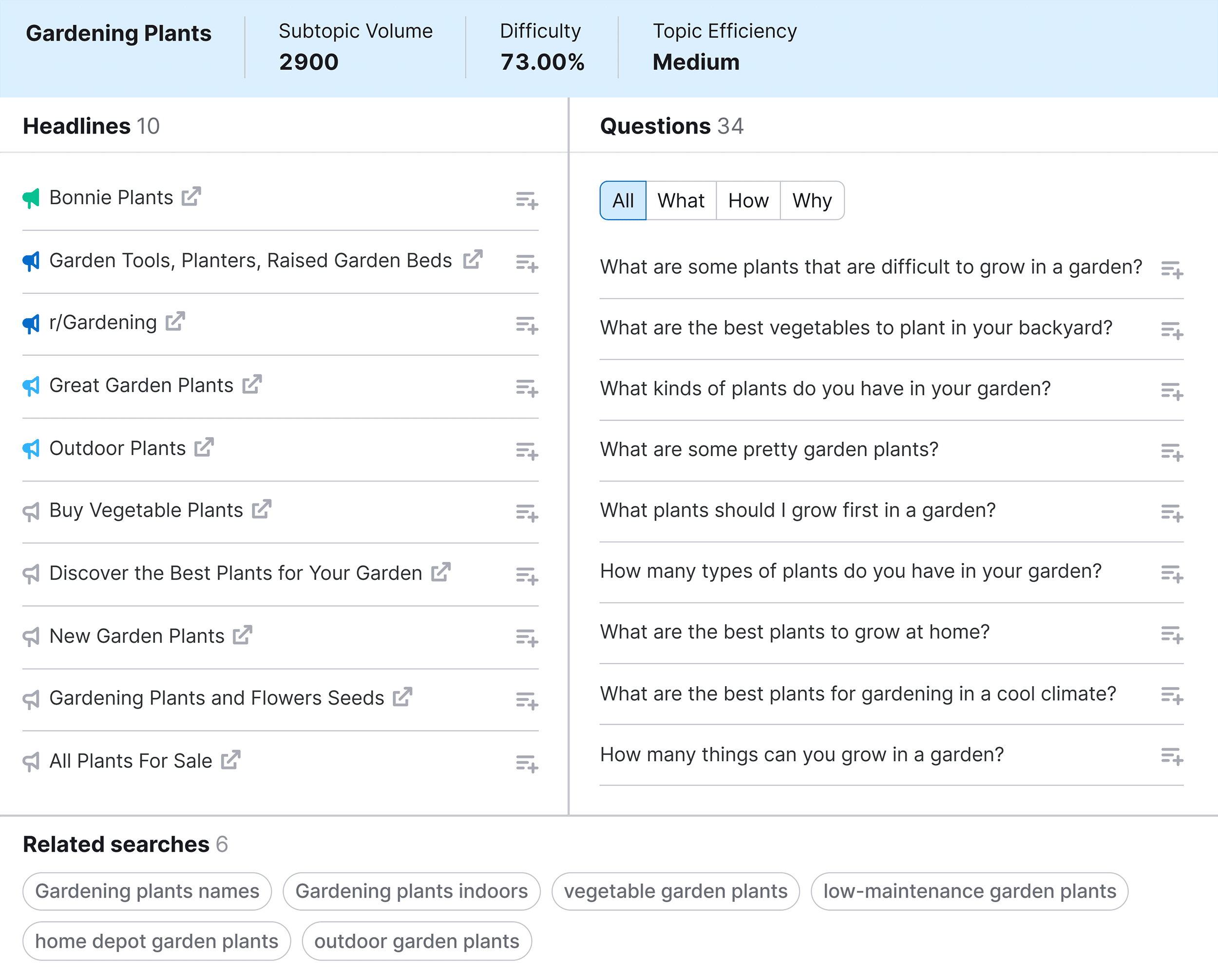
This furnishes you with an array of ideas to build your content and fortify your website’s authority.
Reputation
Reputation stands out as the primary aspect in E-E-A-T, as affirmed by Google in the Quality Rater Guidelines.
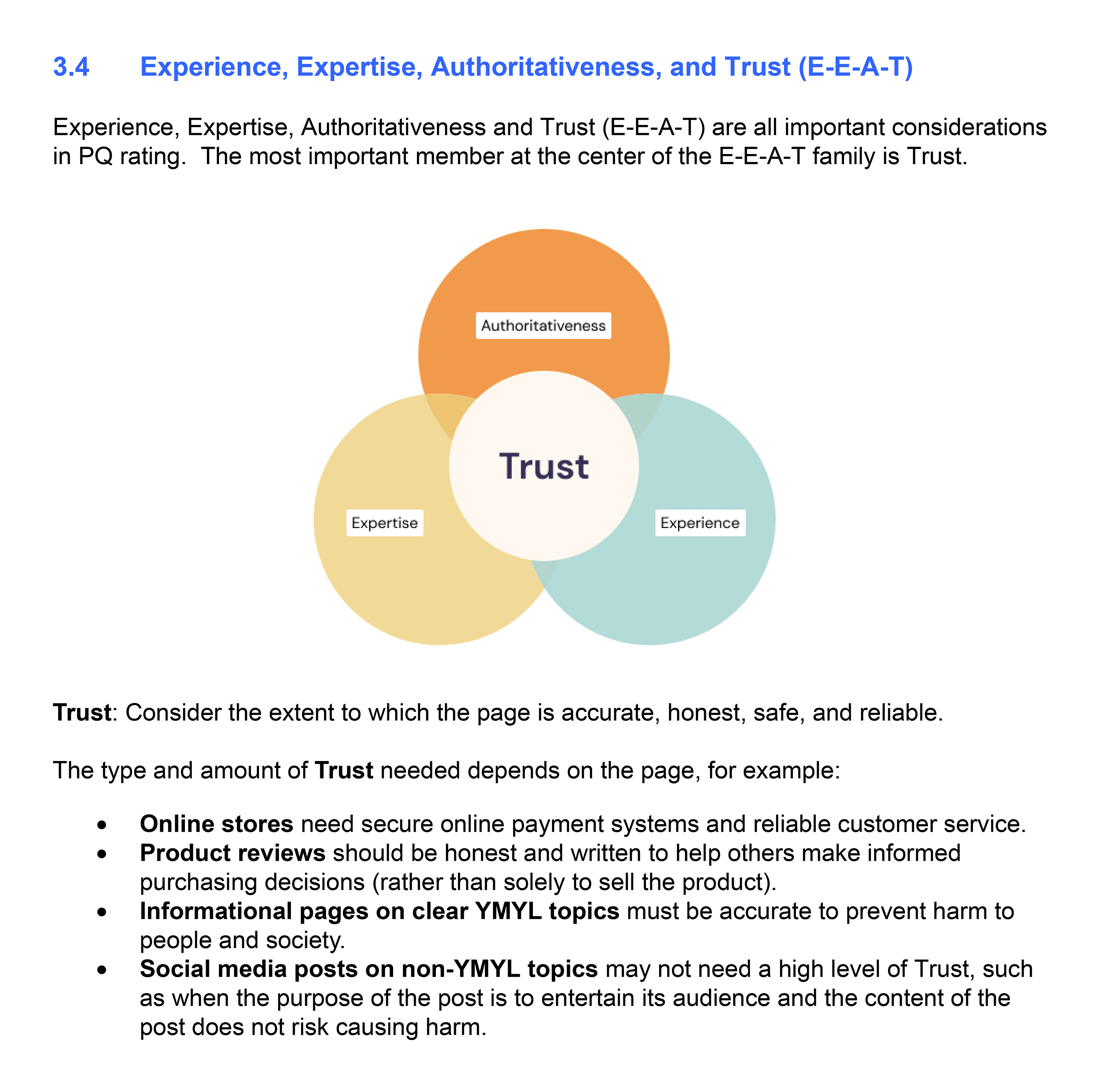
Google deems your site reputable if it’s precise, truthful, secure, and dependable.
Nevertheless, it is important to recognize that a page might display experience, proficiency, and authority but still be deemed untrustworthy by Google’s Quality Raters.
Nevertheless, the significance of trustworthiness for a page or site varies based on the content type. Google assesses trustworthiness in accordance with the content’s intended objective.
For example, a page sharing financial insights necessitates greater trustworthiness than a blog post offering suggestions on the finest taco eateries in LA.
In the financial realm, accuracy is paramount as misinformation could significantly impact readers. Conversely, the roundup of top taco spots in LA relies more on personal perspectives than concrete facts. Consequently, the criteria for trustworthy information vary significantly.
Imagine advising US citizens that they don’t require a visa for a trip to Japan, only to realize they actually do.
If such counsel is featured on your site, both users and Google’s Quality Raters will regard your site as untrustworthy.
This misstep could result in negative consequences.
Let’s examine another scenario.
For an e-commerce platform, it is vital for shoppers to trust that online transactions are secure, and their payment information remains confidential.
In the absence of SSL (Secure Socket Layer) encryption or HTTPS (Hypertext Transfer Protocol Secure) implementation on your site, users are unlikely to place their trust in you.
Semrush’s Site Audit tool offers a swift and simple means of assessing your site’s security.
Here’s a guide on using it:
Enter your domain into the search bar and click “Start Audit.”
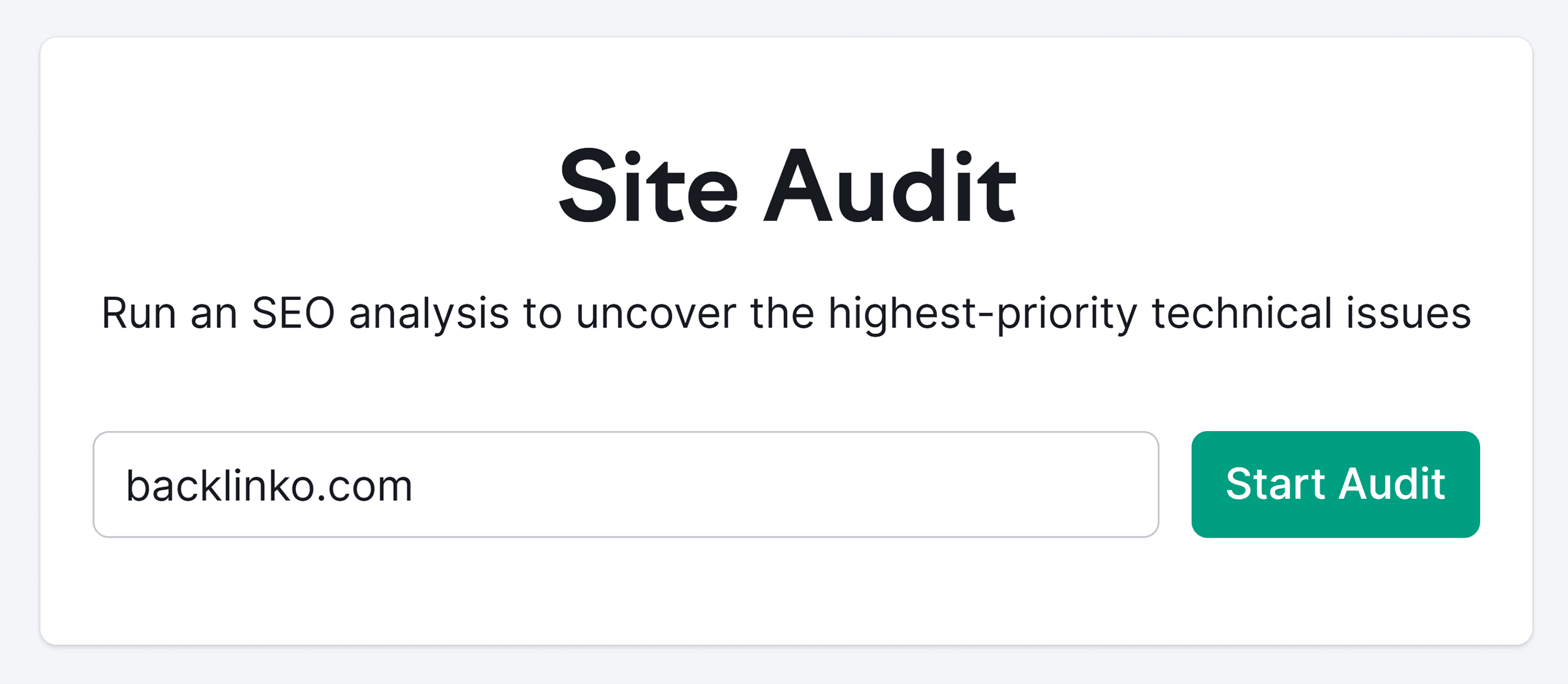
You will then be directed to the “Site Audit Settings” menu. If you are content with the default settings, click “Start Site Audit.”
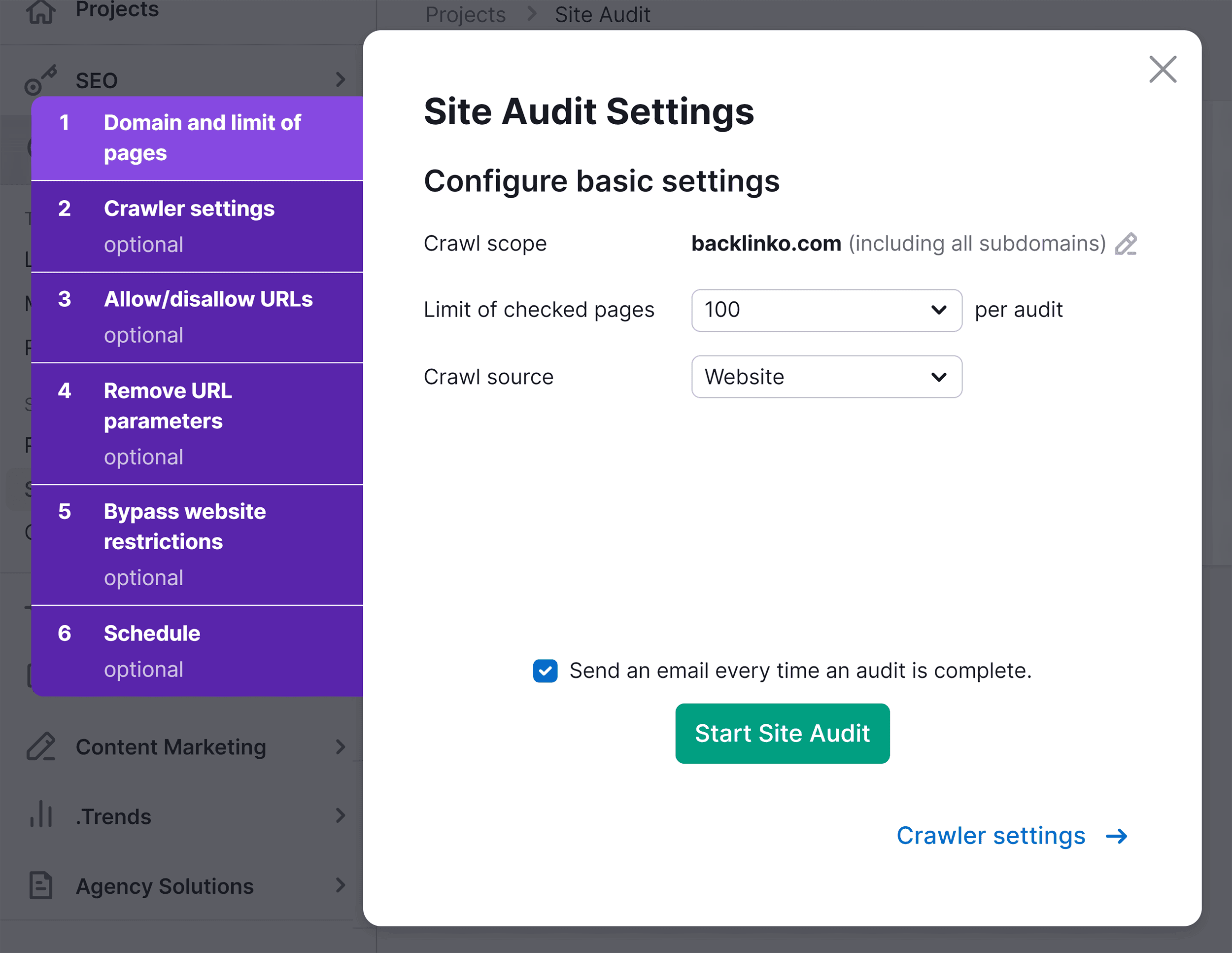
Upon completion of the audit, click on your project name to review the report.
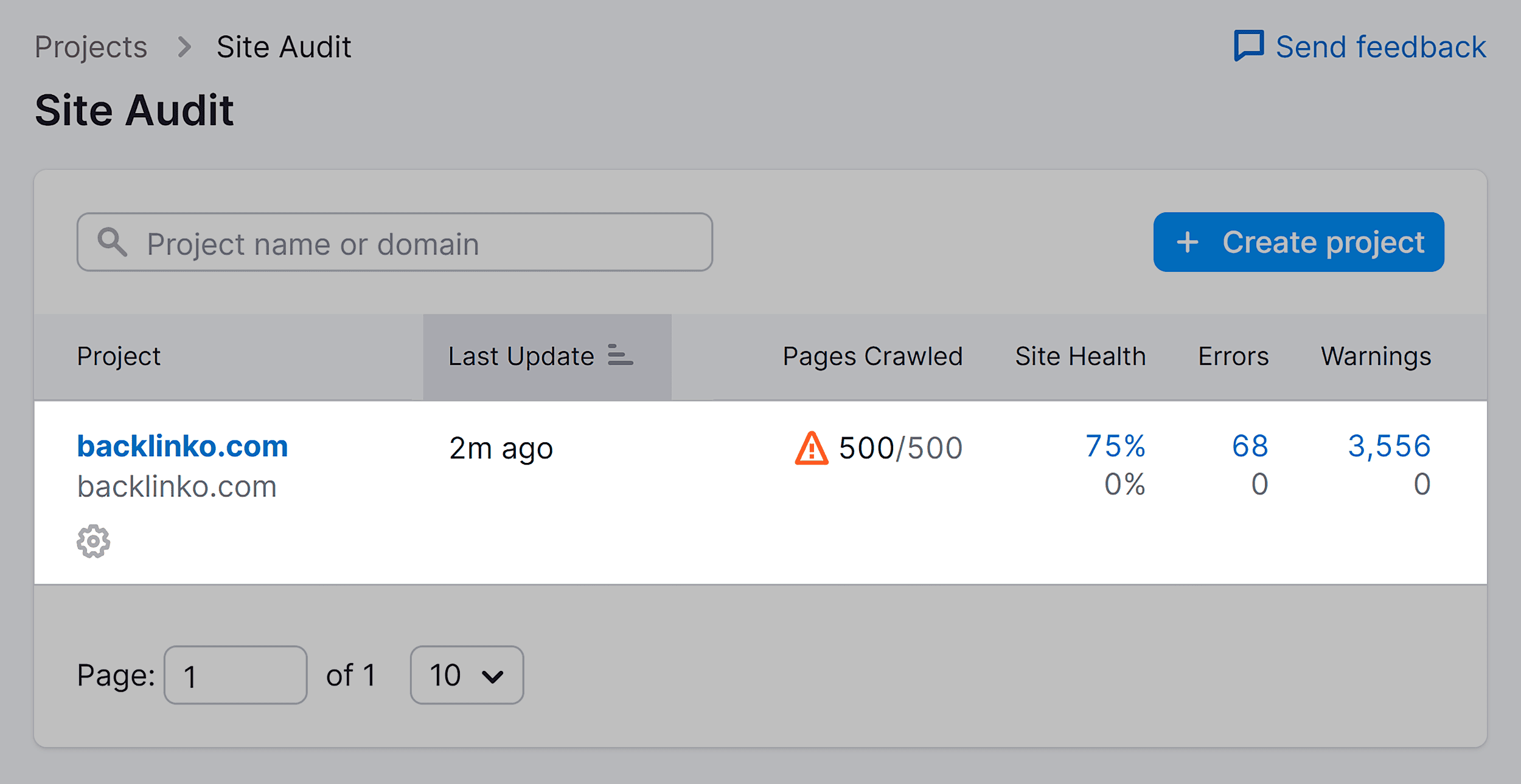
Under “Thematic Reports” on the subsequent page, locate the “HTTPS” widget and click “View details.”
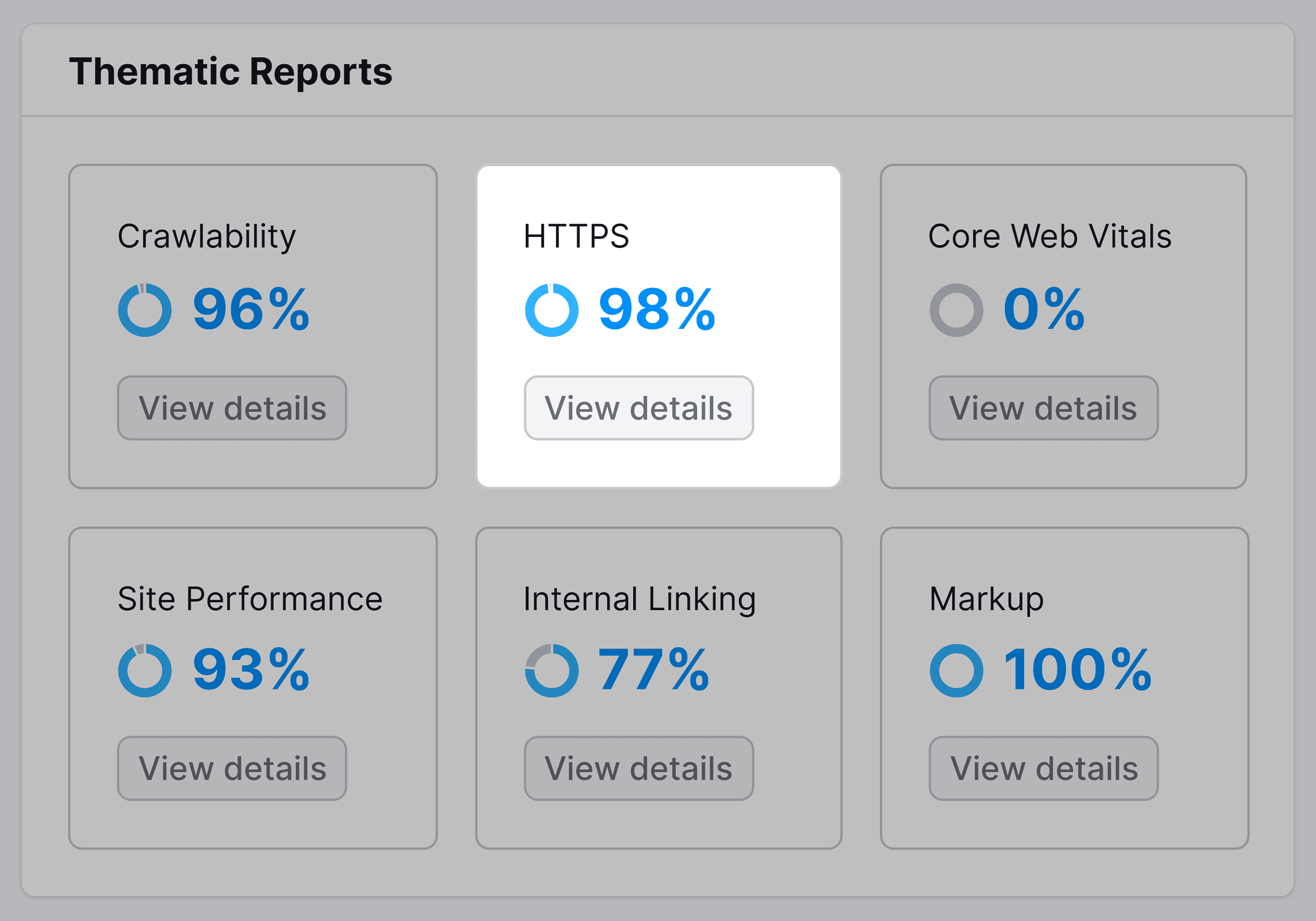
The tool will provide you with:
- Your HTTPS Implementation score
- Status of your security certificates and server security
- Evaluation of your site architecture’s security
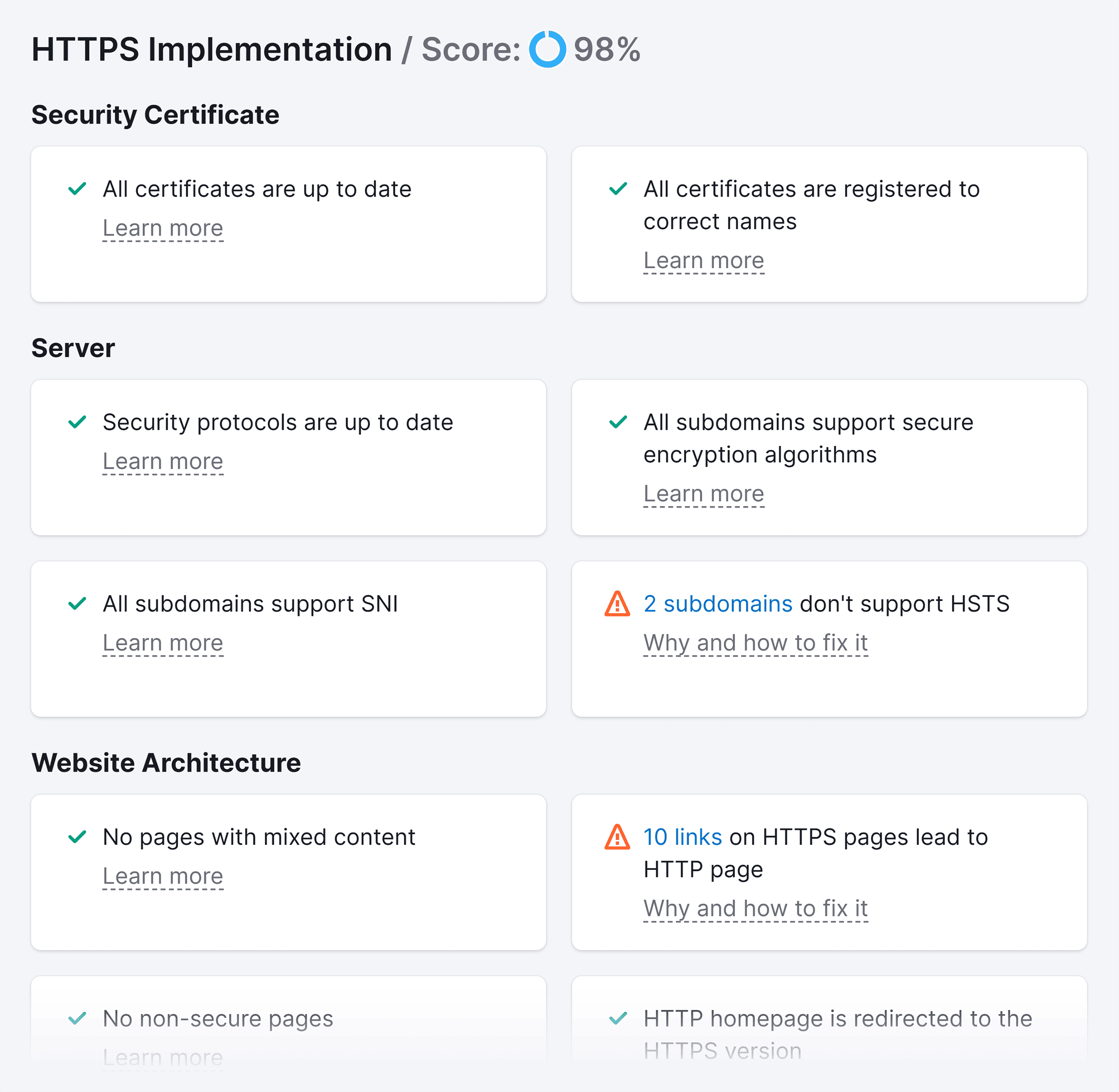
IfIf any security issues are discovered during the audit of your website, you can click on the problem to learn more about how to resolve it.
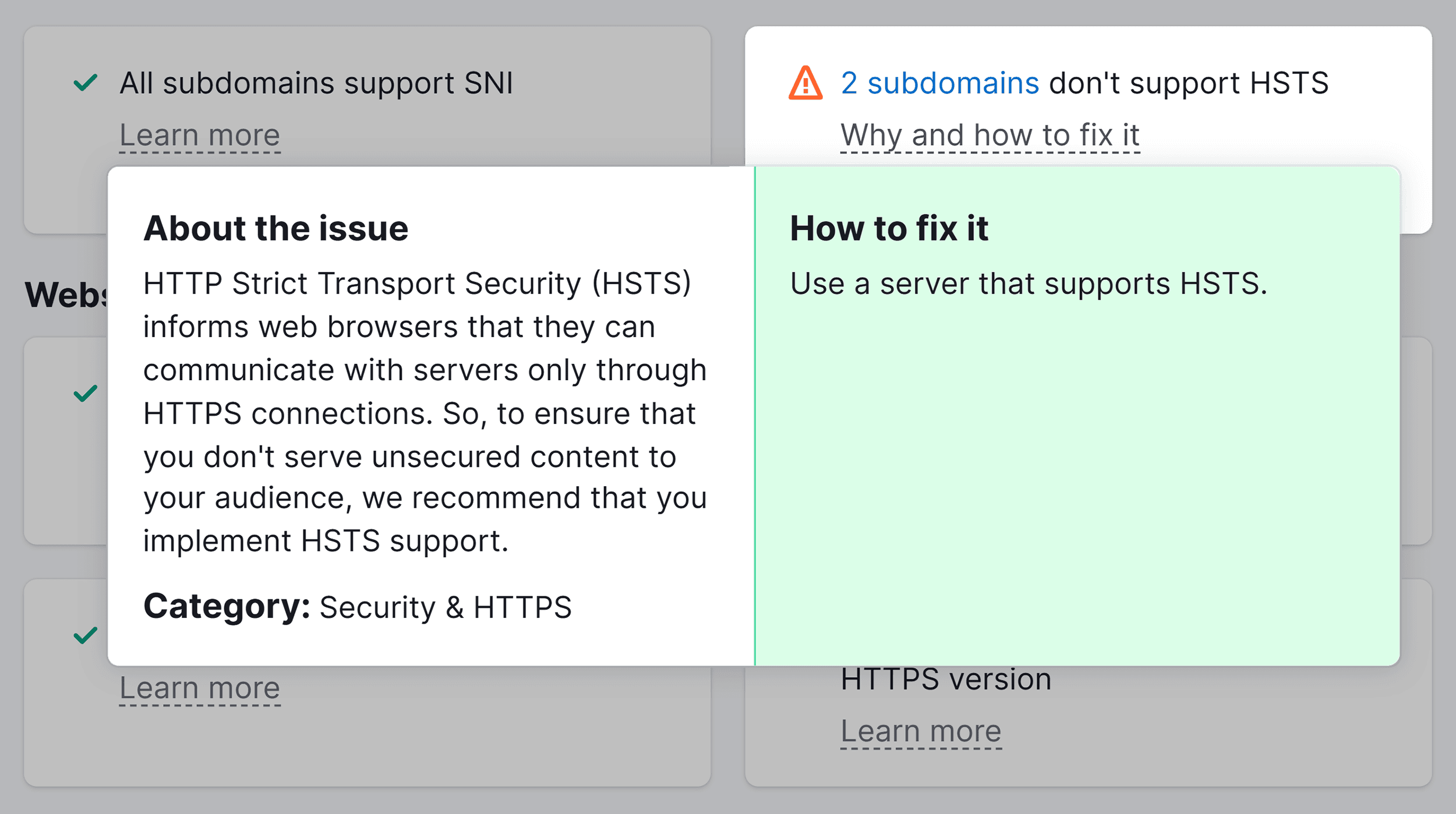
Establishing Trust and Credibility
Demonstrating trust on your website is relatively straightforward when your intentions are transparent.
Consider these strategies to build and showcase credibility:
- Facilitate visitor contact: Depending on your website’s nature, providing accurate contact information is a simple way to instill trust. Ensure your site has an easily accessible contact page listing a physical address, phone number, and email address.
- Implement essential business policies: Including a clear privacy policy, cookie policy, terms and conditions, and returns policy (for e-commerce sites) is crucial for building trust.
- Maintain updated content: Regularly updating content and displaying the last update date helps build credibility. Outdated content can deter trust from visitors.
- Showcase testimonials and reviews: Allowing users to leave feedback and displaying positive testimonials helps in establishing trust. Responsibly addressing negative feedback also demonstrates accountability.
- Ensure secure transactions: If your website processes payments or sensitive data, prioritize customer safety. Use HTTPS connections, maintain a valid SSL certificate, and offer trusted payment gateways.
- Display trust indicators: Showcasing industry affiliations or security seals from reputable providers helps enhance trustworthiness.
- Feature press mentions: Highlight logos of prominent media publications that have discussed your brand. Public trust in established media outlets can bolster credibility.
Evaluating E-A-T Levels and Google’s Search Quality Rater Guidelines
Google’s guidelines define various levels of E-A-T: "Lowest," "Lacking," "High Level," and "Very High Level."
Strive to align your website with the highest possible E-A-T level.
Lowest E-A-T
Pages in this category are commonly spammy and lack credibility, risking harm to users. They fail to deliver a positive user experience and can be easily identified.
These could include pages promoting fraudulent or criminal activities, representing the lowest quality and trustworthiness on the internet.
These are pages users would instinctively distrust.
Lacking E-E-A-T
Google’s guidelines clarify that a page can lack E-A-T even on an otherwise trustworthy site.
For example, consider a health and fitness blog with credible content across most topics except for an unrelated post about expensive guitars.
Google emphasizes the importance of E-A-T specific to the page’s content, regardless of the overall reputation of the site.
“The Low rating should be used if the page lacks appropriate E-A-T for its purpose. No other considerations such as positive reputation or the type of website can overcome a lack of E-A-T for the topic or purpose of the page.”
Google also outlines traits of pages lacking E-A-T:
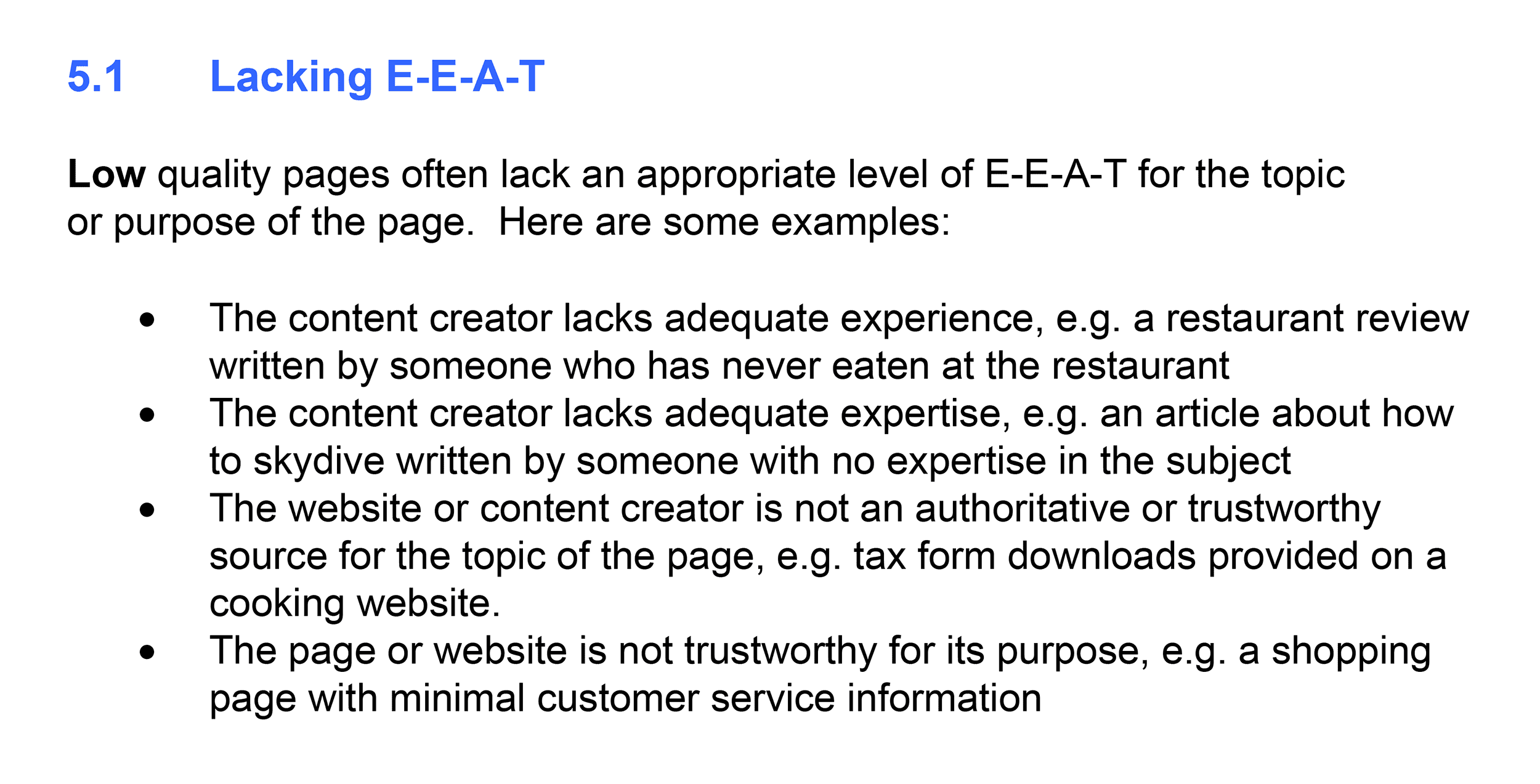
Unlike pages with the lowest E-A-T levels, those lacking E-A-T are not necessarily harmful but often lack expertise or originality.
Google advises raters to watch for:
- Subpar content lacking originality, talent, or relevant information
- Sensationalized or misleading titles
- Content from sources with dubious reputations
- Insufficient information about content creators or sites
- Excessive ads overshadowing the main content
Consider an example such as a poorly written article with distracting ads that would likely receive a low E-A-T rating by Google’s standards.
High E-A-T
Pages with high E-A-T exhibit expertise, credibility, and trustworthiness, often required for top-quality content.
The page’s purpose and topic determine the criteria for achieving high E-A-T.
An exemplary high E-A-T page from Google’s guidelines:
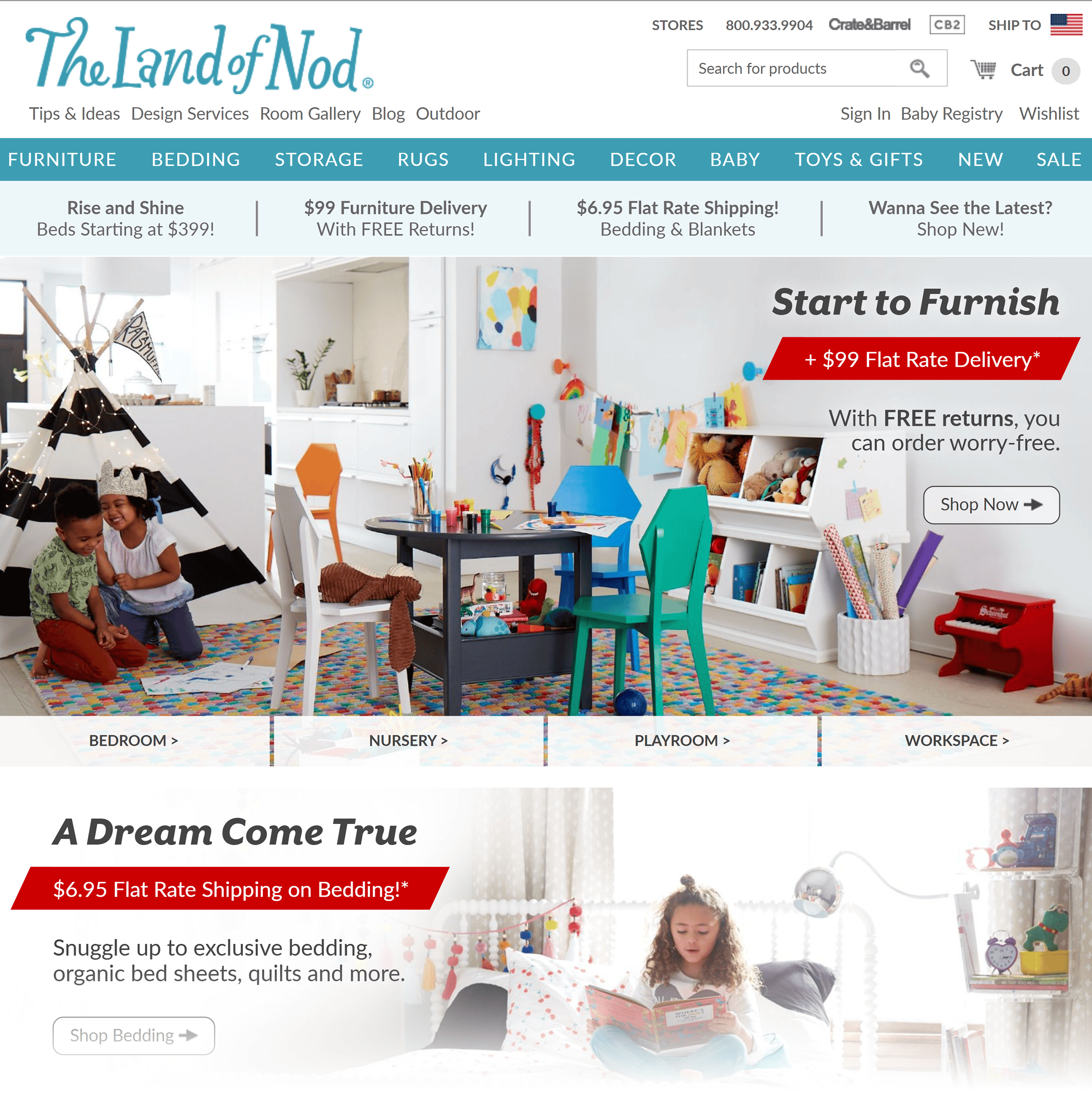
According to Google, this page demonstrates expertise and credibility in selling unique children’s furniture, embodying the essence of high E-A-T.
Very High E-A-T
Pages with very high E-A-T provide deep expertise, trustworthiness, and credibility, often essential for top-tier content.
Pages that boast a very high level of Expertise, Authoritativeness, and Trustworthiness are typically crafted by specialists or featured on websites recognized as the top authority on a particular subject. This elevated E-A-T level also plays a crucial role for Quality Raters when assigning a "highest quality" label to pages.
Such pages adhere to the essential criteria necessary for establishing themselves as one of the most reliable sources online for a given topic.
According to Google:
“A content creator with extensive experience may be deemed to possess a very high E-A-T for subjects where experience is the primary factor influencing trust. A high level of expertise can validate a very high E-A-T evaluation.”
For example, when reading an article regarding a significant financial matter, it is logical to expect the author to be a financial expert with relevant experience in that area.
An essential aspect to consider when striving to publish content that showcases a very high level of Expertise, Authoritativeness, and Trustworthiness is to pose a series of questions to yourself:
- How critical is firsthand experience for this subject?
- How vital are formal expertise and education for this topic?
- Which factors contribute to a website or content creator being seen as trustworthy in this field?
While very high E-A-T can vary significantly between different topics, the foundational principles remain constant.
Now, let’s explore a page that exemplifies a remarkably high level of E-A-T.
Consider an article on the CNBC website discussing the Chinese economy and Huawei’s swift expansion. Although the author is mentioned, mere identification is insufficient.
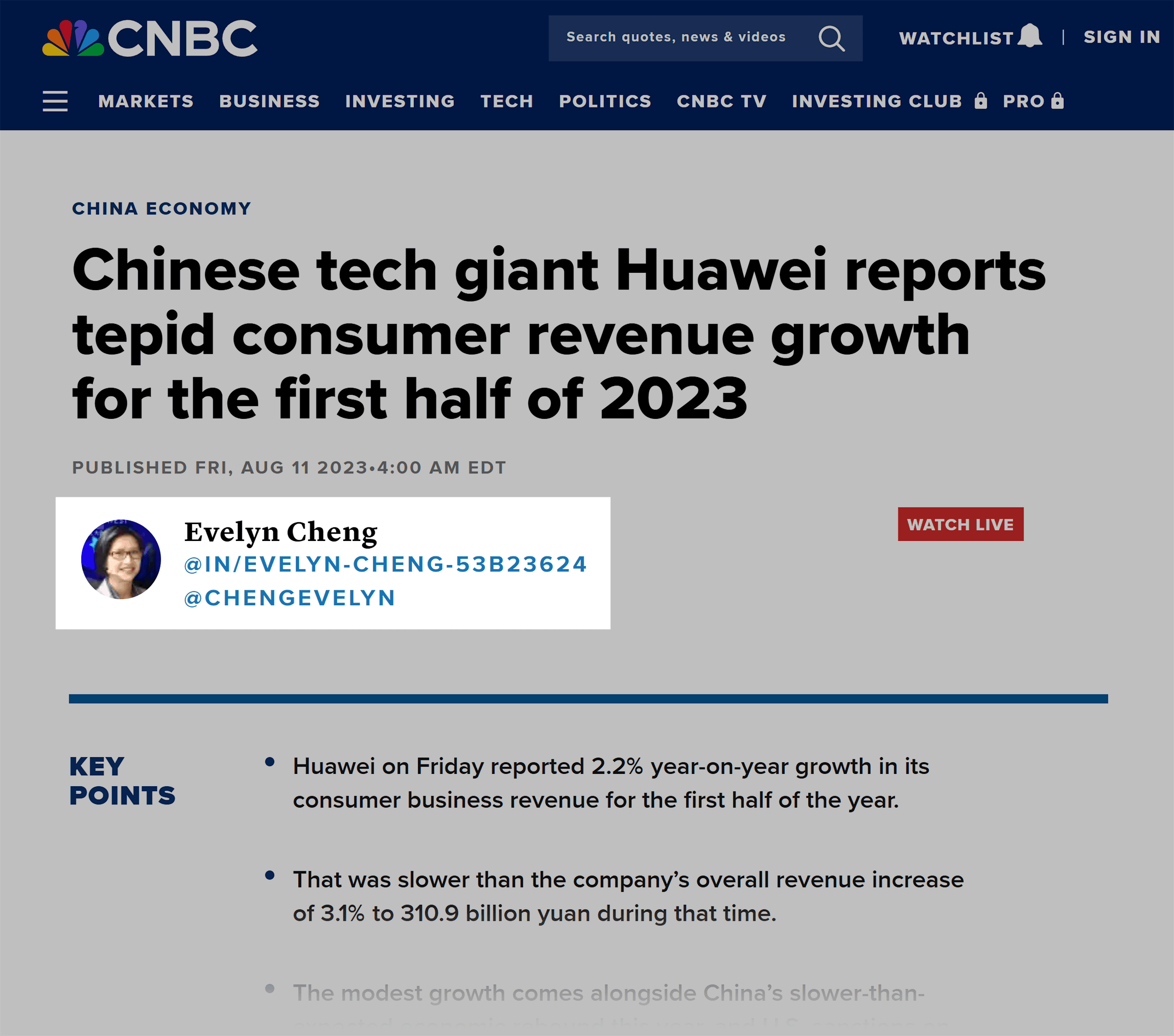
Clicking on the author’s name leads to a bio page providing details about them. This reveals that the author is a senior correspondent specializing in reporting on China’s economic landscape.
An author affiliated with one of the world’s premier publications, focusing on reporting the Chinese economy, indisputably possesses the requisite experience and expertise needed to cover this subject.

The information clearly highlights the author’s experience, expertise, and authority, instilling trust in the article’s content.
This level of detail is what users anticipate when engaging with financial-related content.
11 Effective Techniques for Establishing and Displaying E-A-T
Developing and showcasing E-A-T need not be challenging, and there exist numerous methods to facilitate this process. We have previously shared some illustrations.
Below are 11 practical strategies to enhance your site’s reputation and align with Google’s perception of your website’s E-A-T.
1. Utilize Specialists and Individuals with Direct Experience
Carefully consider who authors your site’s content.
Ideally, the content should be penned by an expert from within your organization well-versed in the subject matter and possessing adequate experience and expertise to address it.
Ask yourself:
- Which individual in our organization is the most seasoned writer on this topic?
- Who is the ideal spokesperson on this matter?
- Who can commit to sharing valuable insights, opinions, and thoughts on the topic?
There may be multiple individuals within the organization meeting these criteria, which is advantageous!
Even if these individuals are unable to compose the content, attempt to schedule regular sessions with them to enrich your content by providing quotes, reviewing material, and examining competitor pieces for gaps.
Avoid the pitfall of publishing content without specifying an author.
Readers desire insight into the person behind the content. Therefore, avoid attributing content to ‘admin’ or your marketing personnel.
Here’s an instance of appropriately crediting content to a relevant author:
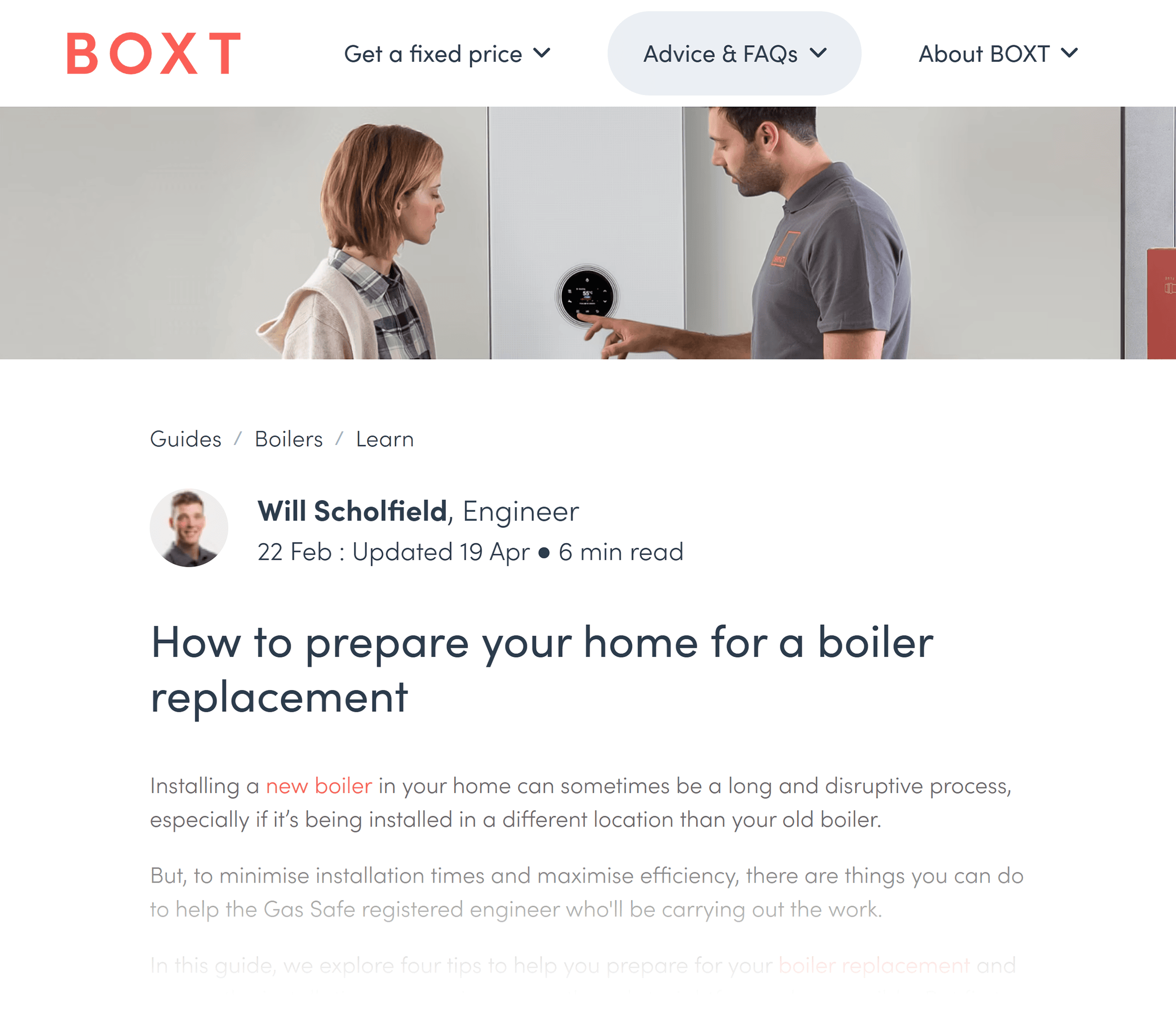
The author, Will Scholfield, is qualified to discuss preparing a home for a boiler replacement, evident from his title as an Engineer.
Enhancing transparency regarding the content’s authorship can significantly benefit readers’ perception.
Remember, experience and expertise are distinct concepts. While certain subjects necessitate formal expertise, high E-A-T can often be demonstrated through experience.
2. Provide Value Beyond Current SERP Content
A vast portion of online content comprises mere reiterations of existing material, yet such content frequently attains top rankings on SERPs.
This is typically referred to as copycat content.
An excellent method of showcasing E-A-T to Google is by bridging knowledge gaps and introducing new perspectives.
This is recognized as information enrichment.
How can you generate information enrichment and differentiate your content from existing top-ranking material?
You’ve guessed it—by leveraging your specialists, be it through adding remarks and quotes to your pages or pinpointing disparities in competing content.
Invite your experts to evaluate the content already ranking prominently in search results and provide feedback on any deficiencies.
In addition to contributing unique insights to your content, ensure comprehensive coverage of a subject to establish subject authority.
3. Cultivate a Favorable Brand Image
Establishing a positive brand image significantly contributes to instilling trust in your audience.
Conversely, a negative brand image can cast doubt on your credibility.
One of the most effective methods of fostering a positive image is by garnering reviews and testimonials.
To receive favorable reviews and testimonials, maintain exceptional service standards, product quality, and overall customer experience.
Depending on your business type, encourage reviews on platforms like Trustpilot and Yelp, alongside your Google Business Profile. Display these prominently on your site.
Remember to respond to these reviews, not just the positive ones.
If faced with a negative review, respond helpfully and transparently. Apologize for the incident and provide guidance to resolve the issue or share how it was addressed.
In case of a positive review, express gratitude to the reviewer for their input and patronage.
Maintaining oversight of reviews may be a daunting task.
Streamline the process by using Semrush’s Review Management tool.
Simply input your business name to get started.
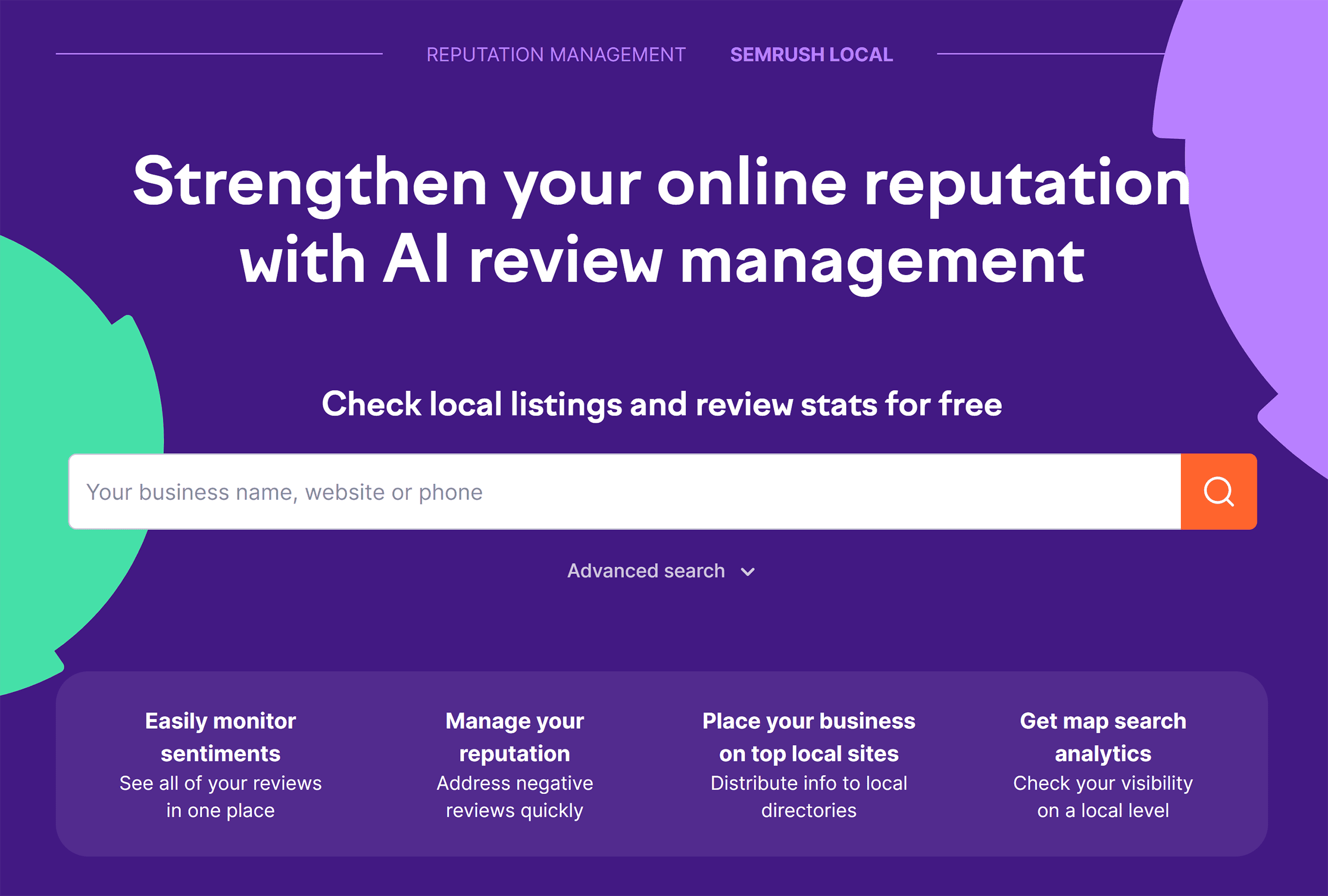
You’ll thenFor Business Information Insertion
Kindly enter your business particulars. Once this is done, you will be able to visualize your company’s star ratings in a stylish graph.
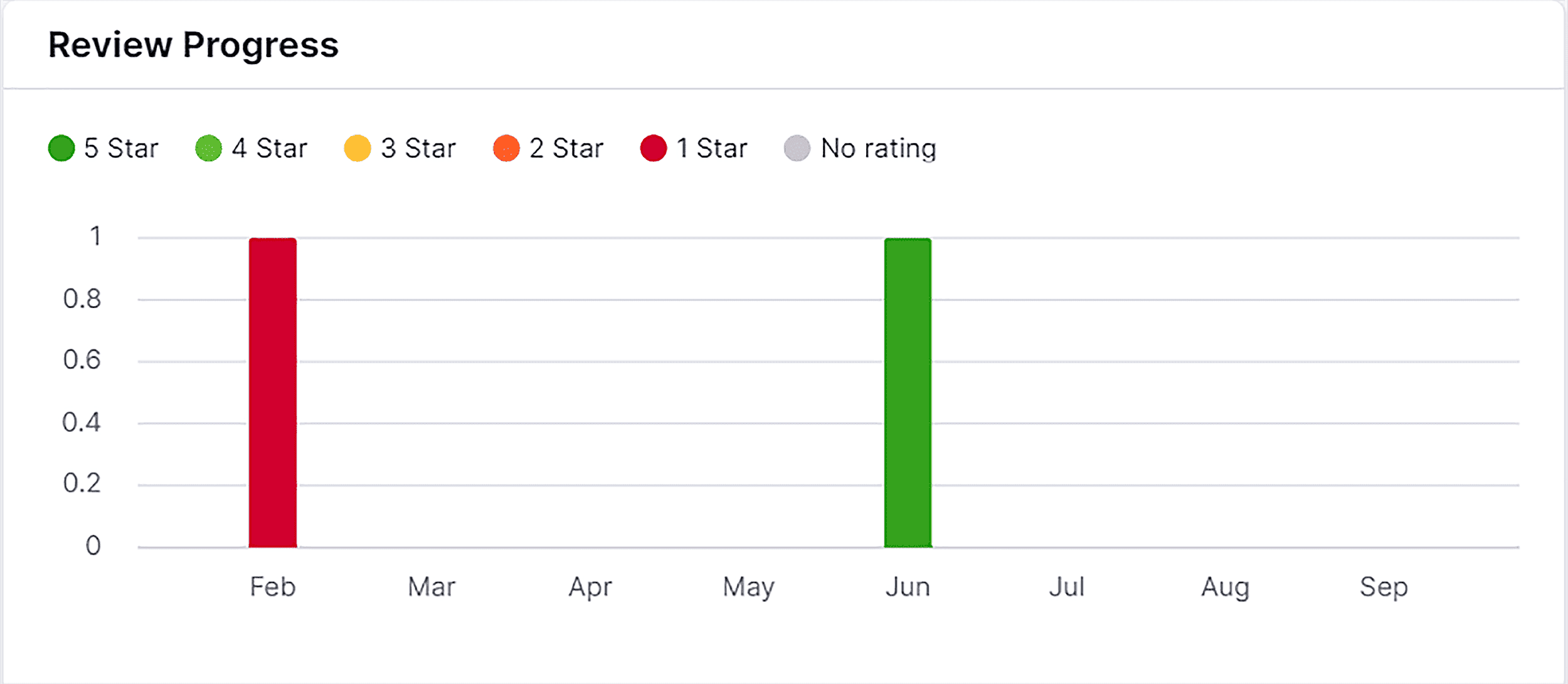
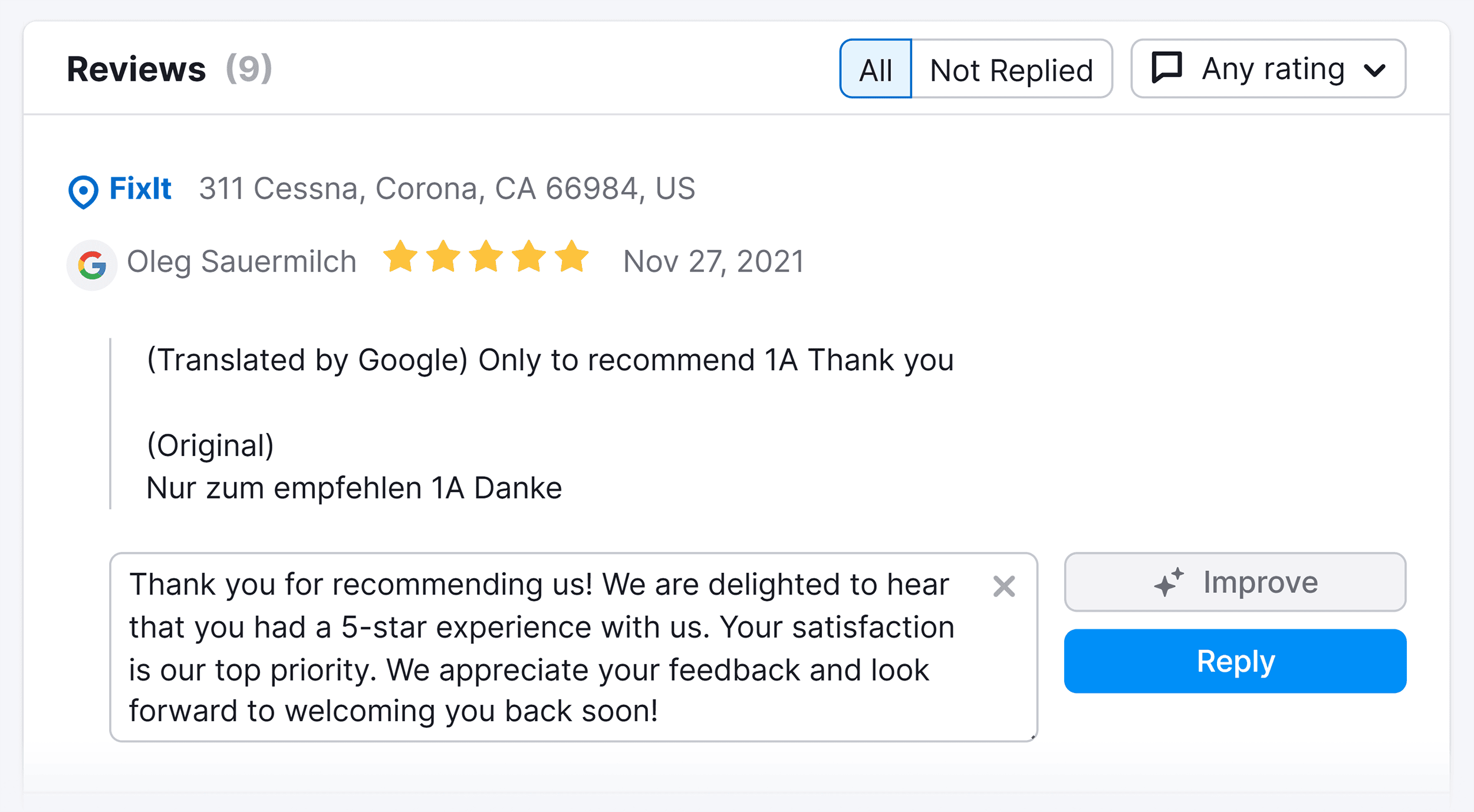
4. Ponder Beyond “Owned” Media and Written Content
- Appear as a guest on pertinent podcasts
- Co-host webinars
- Present at industry events
5. Simplify Identifying Content Creators and Their Backgrounds
Form Independent Author Profile Pages
- Introduction
- A headshot
- Work experience
- Areas of expertise
- Contact details
- List of authored posts
- Showcase of press mentions
In need of inspiration?
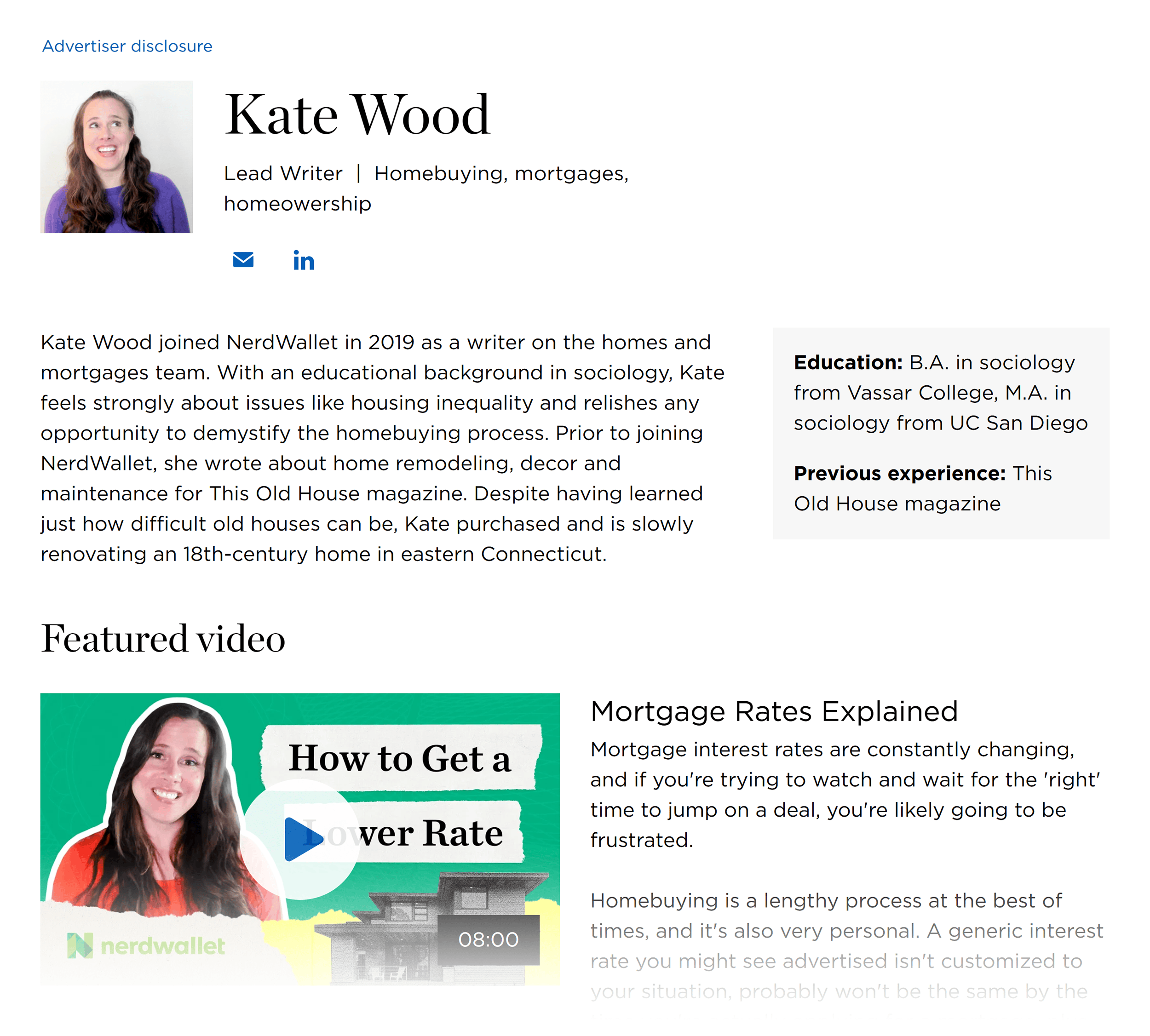
…continuation of the content is unchanged for the remaining steps…and clear delivery information?
Possibly.
Having these elements established does not distinguish you from others because it does not.
Nevertheless, the absence of these crucial business trust elements implies that a website could be deceitful or untrustworthy.
It is also imperative to ensure that locating your contact details is simple. This entails having a contact page that lists your business’s:
- Phone number
- Email address
- Physical address
9. Reference Sources in Your Content
Add references to your content. Also, include links to these sources.
It can be challenging to trust assertions, statistics, or information found online at times. This is frequently due to the absence of explicit acknowledgment of the information source.
Is the data your own? Make it apparent.
Is the information derived from another person’s study or material? Make it evident. And link back to the source.
10. Utilize Your Images and Video Content
One of the most impactful methods to demonstrate your familiarity with the subject you are addressing is by using your images, videos, or other media.
Deploying stock visuals does not aid in demonstrating this and strongly indicates that you lack the expertise you claim to possess.
However, you do not necessarily need to engage a professional photographer. Photos taken with your smartphone are typically more than satisfactory.
Here’s an illustration:
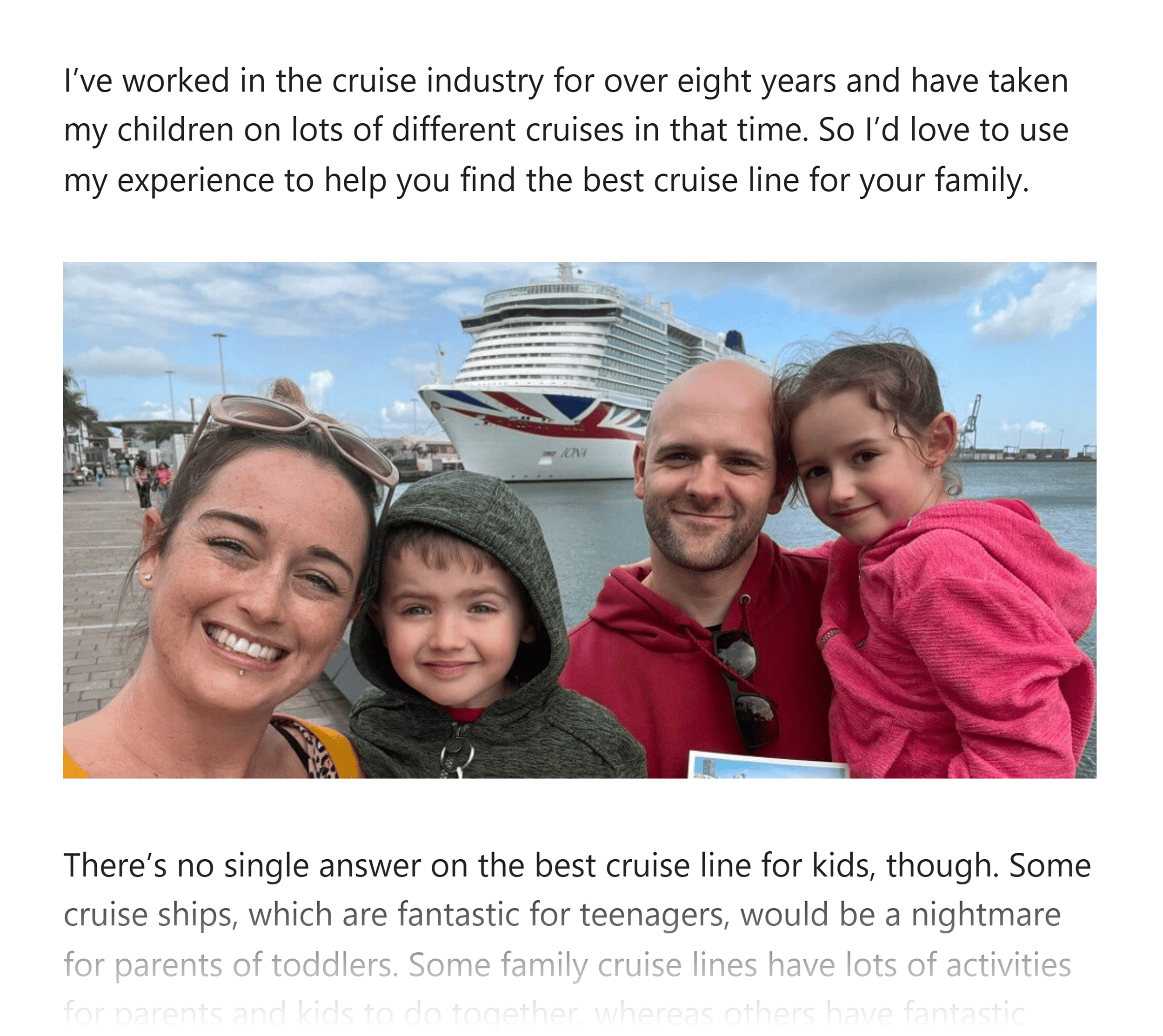
11. Maintain Updated Content
An authority on a topic would not allow their content to become outdated.
A page that has not been updated recently likely contains obsolete or incorrect information.
Regularly assess and revise your site’s content as information evolves on a subject. Typically, the aim is to review the content at least once a year (preferably every six months).
However, do not simply revise the content without indicating this to anyone.
Show the date of the last content review and update. This can significantly help users trust the accuracy of the content.
Here’s how this is displayed on Backlinko:
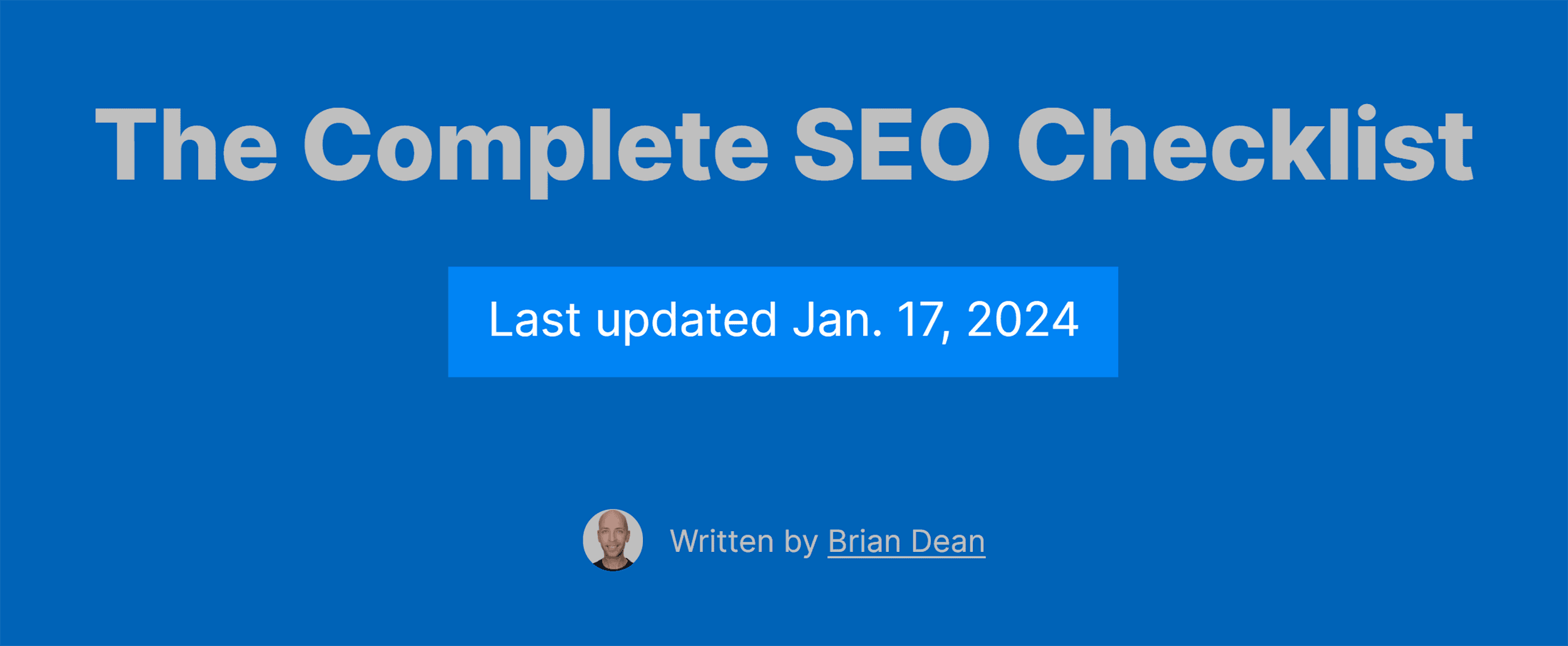
It is simple to determine how recently this was updated.
Common Questions About E-E-A-T
Here are responses to some frequently asked questions on E-E-A-T.
Are there specific industries or niches where e-e-a-t is crucial for SEO success?
While E-E-A-T is critical for all websites, it is particularly vital for those dealing with “Your Money or Your Life” (YMYL) subjects.
These pages could have significant consequences on people’s health and finances if the information offered is inaccurate or if the sites are untrustworthy. There is a much higher necessity for content created by individuals with suitable expertise.
Some examples of YMYL niches include:
- Finance
- Healthcare
- Legal
- News and current events
If you operate a site in a YMYL niche, adhering to E-E-A-T principles is essential, and you should anticipate building and demonstrating more signals than other sites.
Your audience must trust the information you provide, and you must reduce the risk of causing harm to readers.
Is it possible to falsify E-E-A-T signals?
E-E-A-T is something that cannot and should not be counterfeited.
Remember that E-E-A-T involves establishing and presenting the signals that Quality Raters seek, and these are elements that cannot be falsified.
Why?
Creating a positive reputation relies on what others say about you. While you can fabricate your own self-praise, it will not be substantiated by external third-party sources.
Are there tools to evaluate a website’s E-E-A-T status?
No, there are no tools that can gauge your website’s E-E-A-T level.
Since E-E-A-T is not a solitary, quantifiable ranking factor, there is no definitive E-E-A-T score or any metric that a tool can assess.
The most effective method to evaluate your site’s E-E-A-T level is to acquaint yourself with Google’s Quality Rater Guidelines and the criteria contained within them. Compare your web pages with the examples provided and the standards outlined for raters.
What are some prevalent E-E-A-T blunders?
E-E-A-T remains a vastly misunderstood SEO concept, leading to much confusion and errors in its development and demonstration.
The typical mistakes we observe regarding E-E-A-T include:
- Creating fictional authors
- Misrepresenting expertise
- Publishing low-quality content that imitates existing rank-worthy content
- Neglecting on-page and off-page signals
- Missing (or difficult to locate) contact details
- Omitting references or citations within the content
- Outdated content
- Lack of positive reviews for the business or its products
- Not clearly attributing content authors with their experience and expertise
- Failing to secure the site with SSL encryption
- Usage of stock visuals
- Having a feeble About Us section
What if you cannot persuade your business’s authorities to generate content?
You might struggle to engage experts or individuals with direct knowledge on a subject to produce content.
If that is the scenario, you have several options. However, to establish and showcase E-E-A-T to a sufficient extent, collaborating with one or more experts is necessary.
One approach could involve dedicating, say, an hour or two each month for them to discuss the primary topics you plan to address.
Record these discussions, utilize them to craft content on their behalf, have them review the content, and include them on the page as a reviewer.
Alternatively, you could author and publish content under your name but incorporate quotes and comments from the experts. This method still leverages the expertise of these individuals in your content.
Engaging with external experts and leveraging their insights in this manner is also a viable option.
Attain Success with E-E-A-T in 2024
E-E-A-T is a pivotal component for attaining elevated search engine rankings in 2024.
Follow our all-encompassing guide to ensure that you exhibit your experience, expertise, authenticity, and trust to Google and your audience.
While you are here, explore our The Ultimate Local SEO Checklist in 2024.


